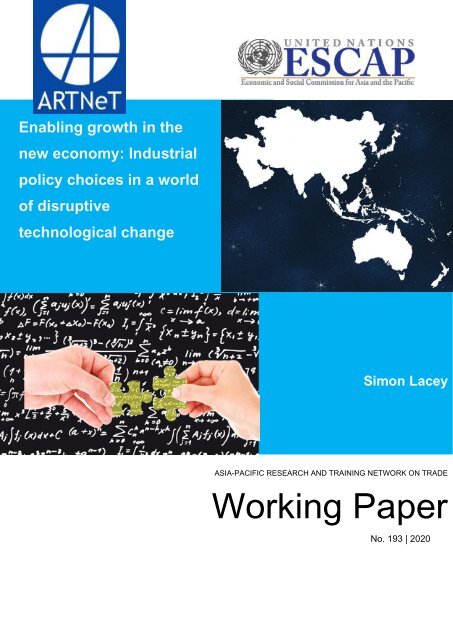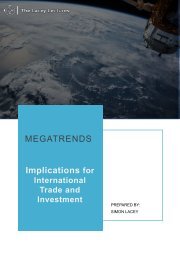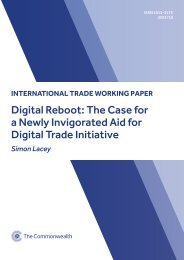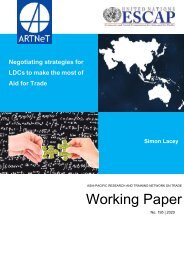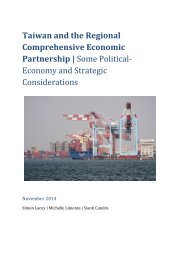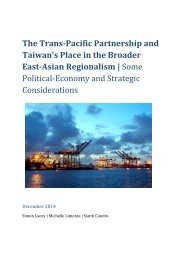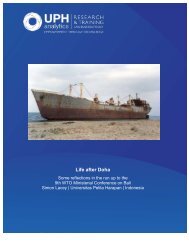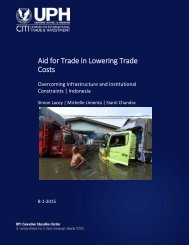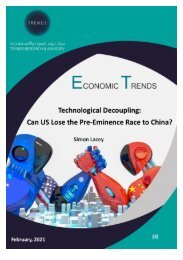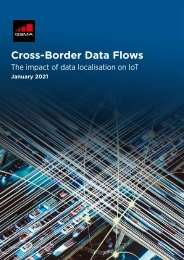Enabling Growth in the New Economy: Industrial policy choices in a world of disruptive technological change
This is one of two research papers I wrote for the United Nations Economic and Social Committee for Asia and the Pacific (UNESCAP) at the start of 2020. As the title suggests, it looks at what governments can do to enable economic growth when the conventional path to achieving this could be closing due to disruptive technologies such as automation and robotics.
This is one of two research papers I wrote for the United Nations Economic and Social Committee for Asia and the Pacific (UNESCAP) at the start of 2020. As the title suggests, it looks at what governments can do to enable economic growth when the conventional path to achieving this could be closing due to disruptive technologies such as automation and robotics.
You also want an ePaper? Increase the reach of your titles
YUMPU automatically turns print PDFs into web optimized ePapers that Google loves.
<strong>Enabl<strong>in</strong>g</strong> growth <strong>in</strong> <strong>the</strong><br />
new economy: <strong>Industrial</strong><br />
<strong>policy</strong> <strong>choices</strong> <strong>in</strong> a <strong>world</strong><br />
<strong>of</strong> <strong>disruptive</strong><br />
<strong>technological</strong> <strong>change</strong><br />
Simon Lacey<br />
ASIA-PACIFIC RESEARCH AND TRAINING NETWORK ON TRADE<br />
Work<strong>in</strong>g Paper<br />
No. 193 | 2020
The Asia-Pacific Research and Tra<strong>in</strong><strong>in</strong>g Network on Trade (ARTNeT) is an open<br />
regional network <strong>of</strong> research and academic <strong>in</strong>stitutions specializ<strong>in</strong>g <strong>in</strong> <strong>in</strong>ternational<br />
trade <strong>policy</strong> and facilitation issues. ESCAP, WTO and UNCTAD, as key core network<br />
partners, and a number <strong>of</strong> bilateral development partners, provide substantive and/or<br />
f<strong>in</strong>ancial support to <strong>the</strong> network. The Trade, Investment and Innovation Division <strong>of</strong><br />
ESCAP, <strong>the</strong> regional branch <strong>of</strong> <strong>the</strong> United Nations for Asia and <strong>the</strong> Pacific, provides<br />
<strong>the</strong> Secretariat <strong>of</strong> <strong>the</strong> network and a direct regional l<strong>in</strong>k to trade <strong>policy</strong>makers and<br />
o<strong>the</strong>r <strong>in</strong>ternational organizations.<br />
The ARTNeT Work<strong>in</strong>g Paper Series dissem<strong>in</strong>ates <strong>the</strong> f<strong>in</strong>d<strong>in</strong>gs <strong>of</strong> work <strong>in</strong> progress to<br />
encourage <strong>the</strong> ex<strong>change</strong> <strong>of</strong> ideas about trade issues. An objective <strong>of</strong> <strong>the</strong> series is to<br />
publish <strong>the</strong> f<strong>in</strong>d<strong>in</strong>gs quickly, even if <strong>the</strong> presentations are less than fully polished.<br />
ARTNeT Work<strong>in</strong>g Papers are available onl<strong>in</strong>e at www.artnetontrade.org. All material<br />
<strong>in</strong> <strong>the</strong> Work<strong>in</strong>g Papers may be freely quoted or repr<strong>in</strong>ted, but acknowledgment is<br />
requested toge<strong>the</strong>r with a copy <strong>of</strong> <strong>the</strong> publication conta<strong>in</strong><strong>in</strong>g <strong>the</strong> quotation or repr<strong>in</strong>t.<br />
The use <strong>of</strong> <strong>the</strong> Work<strong>in</strong>g Papers for any commercial purpose, <strong>in</strong>clud<strong>in</strong>g resale, is<br />
prohibited.<br />
Disclaimer:<br />
The designations employed and <strong>the</strong> presentation <strong>of</strong> <strong>the</strong> material <strong>in</strong> this Work<strong>in</strong>g<br />
Paper do not imply <strong>the</strong> expression <strong>of</strong> any op<strong>in</strong>ion whatsoever on <strong>the</strong> part <strong>of</strong> <strong>the</strong><br />
Secretariat <strong>of</strong> <strong>the</strong> United Nations concern<strong>in</strong>g <strong>the</strong> legal status <strong>of</strong> any country, territory,<br />
city or area, or <strong>of</strong> its authorities, or concern<strong>in</strong>g <strong>the</strong> delimitation <strong>of</strong> its frontiers or<br />
boundaries. Where <strong>the</strong> designation “country or area” appears, it covers countries,<br />
territories, cities or areas. Bibliographical and o<strong>the</strong>r references have, wherever<br />
possible, been verified. The United Nations bears no responsibility for <strong>the</strong> availability<br />
or function<strong>in</strong>g <strong>of</strong> URLs. The views expressed <strong>in</strong> this publication are those <strong>of</strong> <strong>the</strong><br />
author(s) and do not necessarily reflect <strong>the</strong> views <strong>of</strong> <strong>the</strong> United Nations. The<br />
op<strong>in</strong>ions, figures and estimates set forth <strong>in</strong> this publication are <strong>the</strong> responsibility <strong>of</strong><br />
<strong>the</strong> author(s) and should not necessarily be considered as reflect<strong>in</strong>g <strong>the</strong> views or<br />
carry<strong>in</strong>g <strong>the</strong> endorsement <strong>of</strong> <strong>the</strong> United Nations. Any errors are <strong>the</strong> responsibility <strong>of</strong><br />
<strong>the</strong> author(s). The mention <strong>of</strong> firm names and commercial products does not imply<br />
<strong>the</strong> endorsement <strong>of</strong> <strong>the</strong> United Nations.<br />
© ARTNeT 2020<br />
2
ASIA-PACIFIC RESEARCH AND TRAINING NETWORK ON TRADE<br />
WORKING PAPER<br />
<strong>Enabl<strong>in</strong>g</strong> growth <strong>in</strong> <strong>the</strong> new economy:<br />
<strong>Industrial</strong> <strong>policy</strong> <strong>choices</strong> <strong>in</strong> a <strong>world</strong> <strong>of</strong> <strong>disruptive</strong> <strong>technological</strong><br />
<strong>change</strong><br />
Simon Lacey 1<br />
Please cite this paper as:<br />
Lacey, Simon (2020). “<strong>Enabl<strong>in</strong>g</strong> growth <strong>in</strong> <strong>the</strong> new economy: <strong>Industrial</strong> <strong>policy</strong><br />
<strong>choices</strong> <strong>in</strong> a <strong>world</strong> <strong>of</strong> <strong>disruptive</strong> <strong>technological</strong> <strong>change</strong>”, ARTNeT Work<strong>in</strong>g<br />
Paper Series No. 193, June 2020, Bangkok: ESCAP.<br />
Available at https://artnet.unescap.org<br />
1<br />
Senior Lecturer <strong>in</strong> International Trade at <strong>the</strong> University <strong>of</strong> Adelaide, Australia, e-mail:<br />
simon.lacey@adelaide.edu.au. This paper is one <strong>of</strong> <strong>the</strong> outputs under <strong>the</strong> project titled “Streng<strong>the</strong>n<strong>in</strong>g<br />
capacity <strong>of</strong> ESCAP member States to utilize trade as a means <strong>of</strong> implementation for susta<strong>in</strong>able<br />
development” funded from ESCAP’s Regular Programme <strong>of</strong> Technical Cooperation. The author is<br />
grateful to <strong>the</strong> ARTNeT secretariat for <strong>the</strong> technical support <strong>in</strong> prepar<strong>in</strong>g this paper for dissem<strong>in</strong>ation.<br />
3
Abstract<br />
This paper exam<strong>in</strong>es recent <strong>technological</strong> developments and how <strong>the</strong>y could impact<br />
efforts by <strong>policy</strong>makers and political leaders <strong>in</strong> develop<strong>in</strong>g countries to harness trade<br />
and <strong>in</strong>vestment liberalization to achieve economic development outcomes.<br />
It beg<strong>in</strong>s by discuss<strong>in</strong>g some <strong>of</strong> <strong>the</strong> proven elements to mov<strong>in</strong>g up <strong>the</strong> development<br />
ladder but <strong>the</strong>n warns that <strong>the</strong> tried and trusted methods and pathways could be clos<strong>in</strong>g<br />
<strong>in</strong> light <strong>of</strong> new <strong>technological</strong> developments such as automation and artificial<br />
<strong>in</strong>telligence, <strong>the</strong> impact <strong>of</strong> which on labor markets promises to be <strong>disruptive</strong> <strong>in</strong> <strong>the</strong> short<br />
to medium term.<br />
The paper provides a set <strong>of</strong> <strong>policy</strong> prescriptions that governments could and should be<br />
contemplat<strong>in</strong>g <strong>in</strong> order to position <strong>the</strong>ir economies to benefit from <strong>the</strong> opportunities <strong>of</strong><br />
<strong>the</strong> new economy but also to shelter <strong>the</strong>ir workforces from any possible downsides that<br />
<strong>the</strong>se new and <strong>disruptive</strong> technologies may br<strong>in</strong>g with <strong>the</strong>m.<br />
Perhaps <strong>the</strong> most important f<strong>in</strong>d<strong>in</strong>g this report has to <strong>of</strong>fer is that <strong>the</strong> most decisive<br />
factor <strong>in</strong> achiev<strong>in</strong>g genu<strong>in</strong>e <strong>change</strong> and tangible development improvements is political<br />
will and <strong>the</strong> determ<strong>in</strong>ation to override <strong>the</strong> resistance to <strong>change</strong> that will <strong>in</strong>evitably come<br />
from entrenched <strong>in</strong>terests (<strong>in</strong>clud<strong>in</strong>g political and economic elites) that benefit from <strong>the</strong><br />
status quo. This is about improv<strong>in</strong>g <strong>the</strong> state <strong>of</strong> economic governance <strong>in</strong> countries and<br />
can only be achieved by embark<strong>in</strong>g upon serious and results-driven reform.<br />
The report discusses some areas <strong>of</strong> reform that seem particularly important <strong>in</strong> light <strong>of</strong><br />
<strong>the</strong> <strong>technological</strong> transformations unfold<strong>in</strong>g, namely skills and education, empower<strong>in</strong>g<br />
<strong>the</strong> private sector and embrac<strong>in</strong>g digitization. It was written before <strong>the</strong> global health<br />
pandemic and ensu<strong>in</strong>g economic shocks unleashed by COVID-19, but its f<strong>in</strong>d<strong>in</strong>gs<br />
rema<strong>in</strong> relevant and <strong>the</strong> urgency for implement<strong>in</strong>g its recommendations has <strong>in</strong>creased<br />
as a result <strong>of</strong> <strong>the</strong> many sudden and drastic <strong>change</strong>s <strong>the</strong> global economy has been<br />
forced to undergo as a result <strong>of</strong> this crisis.<br />
Keywords: Economic governance, private sector reform, automation, artificial<br />
<strong>in</strong>telligence, LDCs, Fourth <strong>Industrial</strong> Revolution.<br />
JEL codes: F13, L52, L88, O24, O38<br />
4
Contents<br />
1. Introduction ............................................................................................................. 6<br />
A. Proven paths to export-led growth ................................................................. 6<br />
B. <strong>New</strong> <strong>technological</strong> trends .............................................................................. 7<br />
C. Reforms to enable entrepreneurship ............................................................. 8<br />
D. Reposition<strong>in</strong>g <strong>in</strong> a <strong>world</strong> <strong>of</strong> shift<strong>in</strong>g value cha<strong>in</strong>s ........................................... 8<br />
2. Harness<strong>in</strong>g trade to achieve growth .................................................................... 9<br />
A. Trade, growth and adjustment ....................................................................... 9<br />
B. Historical precedents for success and failure .............................................. 10<br />
C. What <strong>policy</strong>makers need to know ................................................................ 12<br />
3. Assess<strong>in</strong>g <strong>the</strong> impact <strong>of</strong> new technologies ........................................................ 13<br />
A. Production processes becom<strong>in</strong>g smarter .................................................... 14<br />
B. Value cha<strong>in</strong>s becom<strong>in</strong>g shorter ................................................................... 15<br />
C. Capital, skills and <strong>in</strong>tellectual property ga<strong>in</strong><strong>in</strong>g <strong>in</strong> importance ...................... 16<br />
4. Empower<strong>in</strong>g <strong>the</strong> private sector .......................................................................... 17<br />
A. Constra<strong>in</strong>ts on entrepreneurship ................................................................. 17<br />
B. Address<strong>in</strong>g <strong>the</strong> skills gap ............................................................................. 20<br />
C. High-impact <strong>in</strong>terventions ............................................................................ 21<br />
5. Transform<strong>in</strong>g good <strong>in</strong>tentions <strong>in</strong>to outcomes ..................................................... 22<br />
A. Recommendation 1: Devise a roadmap to development ............................. 23<br />
B. Recommendation 2: Become “smarter” ....................................................... 23<br />
C. Recommendation 3: Take <strong>the</strong> task-force approach ..................................... 24<br />
6. Conclusion: Change is never easy .................................................................... 24<br />
List <strong>of</strong> references ...................................................................................................... 26<br />
5
1. Introduction<br />
This paper explores several <strong>technological</strong> trends shap<strong>in</strong>g <strong>the</strong> new economy,<br />
particularly artificial <strong>in</strong>telligence, automation and digitization, with a view to exam<strong>in</strong><strong>in</strong>g<br />
<strong>the</strong> impact <strong>the</strong>y are likely to have on <strong>policy</strong> space <strong>in</strong> <strong>the</strong> area <strong>of</strong> <strong>in</strong>dustrialization and<br />
economic development. It argues that <strong>the</strong> w<strong>in</strong>dow <strong>of</strong> opportunity for follow<strong>in</strong>g <strong>the</strong><br />
classic export-led growth model, whereby economies move from agriculture to labour<strong>in</strong>tensive,<br />
lower value-added manufactur<strong>in</strong>g and on to higher value-added<br />
manufactur<strong>in</strong>g and services, may be clos<strong>in</strong>g rapidly, forc<strong>in</strong>g <strong>policy</strong>makers and<br />
entrepreneurs to be more <strong>in</strong>novative and assertive <strong>in</strong> how <strong>the</strong>y identify and leverage<br />
growth opportunities.<br />
The paper also posits that <strong>in</strong> order to achieve <strong>in</strong>clusive and broad-based economic<br />
growth, political leaders and <strong>policy</strong>makers need to have <strong>the</strong> will<strong>in</strong>gness and expertise<br />
to identify and elim<strong>in</strong>ate any constra<strong>in</strong>ts hold<strong>in</strong>g back micro and small enterprises and<br />
stifl<strong>in</strong>g entrepreneurship <strong>in</strong> <strong>the</strong>ir economies more generally. Do<strong>in</strong>g this will allow <strong>the</strong><br />
private sector to grow and permit <strong>the</strong> most efficient firms to connect with regional or<br />
global supply cha<strong>in</strong>s, <strong>the</strong>reby enabl<strong>in</strong>g all k<strong>in</strong>ds <strong>of</strong> positive feedback loops and allow<strong>in</strong>g<br />
for <strong>the</strong> emergence <strong>of</strong> a flourish<strong>in</strong>g private sector, toge<strong>the</strong>r with all <strong>the</strong> o<strong>the</strong>r<br />
improvements <strong>in</strong> socio-economic development outcomes this underp<strong>in</strong>s.<br />
A rise <strong>in</strong> trade tensions comb<strong>in</strong>ed with o<strong>the</strong>r external shocks is likewise exercis<strong>in</strong>g its<br />
own set <strong>of</strong> push and pull effects on production and consumption patterns, which create<br />
new opportunities for more agile and strategically placed develop<strong>in</strong>g countries that are<br />
<strong>in</strong> a position to capture parts <strong>of</strong> production processes and value cha<strong>in</strong>s as firms choose<br />
to relocate from those markets most affected by or at risk from trade tensions and o<strong>the</strong>r<br />
shocks. This applies <strong>in</strong> particular now as firms start pursu<strong>in</strong>g supply cha<strong>in</strong><br />
diversification strategies to improve resilience and robustness and m<strong>in</strong>imize <strong>the</strong><br />
downside risk <strong>of</strong> potential future shocks.<br />
A. Proven paths to export-led growth<br />
The successful growth stories <strong>of</strong> such economies as Japan, Taiwan Prov<strong>in</strong>ce <strong>of</strong> Ch<strong>in</strong>a,<br />
Republic <strong>of</strong> Korea and more recently Ch<strong>in</strong>a, as well as earlier success stories such as<br />
<strong>the</strong> United K<strong>in</strong>gdom, Germany and <strong>the</strong> United States have all followed proven paths to<br />
prosperity that unfold across three broad areas <strong>of</strong> <strong>policy</strong> <strong>in</strong>tervention (Studwell, 2013).<br />
The first <strong>in</strong>volves maximiz<strong>in</strong>g output <strong>in</strong> <strong>the</strong> agricultural sector, particularly <strong>in</strong> staples<br />
6
that can feed a grow<strong>in</strong>g workforce <strong>in</strong>creas<strong>in</strong>gly employed <strong>in</strong> (non-agricultural)<br />
productive activities. The second is to promote a grow<strong>in</strong>g manufactur<strong>in</strong>g sector that<br />
can absorb excess labour from <strong>the</strong> countryside and put it to work <strong>in</strong> (at first) low-skilled<br />
jobs, with <strong>the</strong>se skills ideally be<strong>in</strong>g <strong>the</strong>n put on an upward learn<strong>in</strong>g curve towards<br />
greater productivity and thus <strong>in</strong>creas<strong>in</strong>g wages, <strong>in</strong>clud<strong>in</strong>g from export<strong>in</strong>g to <strong>world</strong><br />
markets. The third step is to harness and co-opt <strong>the</strong> resources <strong>of</strong> <strong>the</strong> f<strong>in</strong>ancial sector<br />
and keep <strong>the</strong>m focused on medium to long-term development outcomes ra<strong>the</strong>r than<br />
short-term pr<strong>of</strong>its and more speculative <strong>in</strong>vestments.<br />
B. <strong>New</strong> <strong>technological</strong> trends<br />
A number <strong>of</strong> <strong>technological</strong> trends are, however, conspir<strong>in</strong>g to close <strong>the</strong> door to <strong>the</strong>se<br />
proven growth paths. Both <strong>in</strong> agriculture and manufactur<strong>in</strong>g we are enter<strong>in</strong>g a new era<br />
<strong>of</strong> smart-farm<strong>in</strong>g and IoT-led <strong>in</strong>dustrialization that is <strong>in</strong>creas<strong>in</strong>gly see<strong>in</strong>g <strong>the</strong> human<br />
element driven to <strong>the</strong> peripheries <strong>of</strong> both very low and very high value-added activities<br />
(Baldw<strong>in</strong>, 2019). The very low value-added activities threaten to trap agricultural<br />
workers <strong>in</strong> perpetual poverty, whereas <strong>the</strong> very high value-added activities could very<br />
well rema<strong>in</strong> beyond <strong>the</strong> level <strong>of</strong> technical sophistication available on <strong>the</strong> vast majority<br />
<strong>of</strong> farms <strong>in</strong> develop<strong>in</strong>g countries and least developed countries (LDCs), because <strong>of</strong> <strong>the</strong><br />
high levels <strong>of</strong> both capital and skills that smart farm<strong>in</strong>g requires.<br />
On production locations across <strong>the</strong> <strong>world</strong>, <strong>in</strong>clud<strong>in</strong>g <strong>in</strong> low-labour cost countries such<br />
as Mexico and Ch<strong>in</strong>a, factory and production automation is <strong>in</strong>creas<strong>in</strong>gly start<strong>in</strong>g to<br />
drive labour to <strong>the</strong> low and high-value add activities so that <strong>the</strong> only (human) workers<br />
left <strong>in</strong> <strong>the</strong> factory are <strong>the</strong> clean<strong>in</strong>g staff and robotic eng<strong>in</strong>eers. This trend is more<br />
pronounced <strong>in</strong> <strong>the</strong> manufactur<strong>in</strong>g sector than it is <strong>in</strong> agriculture, where a lot <strong>of</strong> manual<br />
labour still rema<strong>in</strong>s to be done by humans, at least for <strong>the</strong> immediate future.<br />
Low-skilled services are ano<strong>the</strong>r area <strong>of</strong> economic activity that has provided hundreds<br />
<strong>of</strong> thousands <strong>of</strong> jobs <strong>in</strong> both develop<strong>in</strong>g countries and advanced <strong>in</strong>dustrialized<br />
economies. Th<strong>in</strong>k for example <strong>of</strong> <strong>the</strong> millions <strong>of</strong> people who earn a liv<strong>in</strong>g driv<strong>in</strong>g a car,<br />
truck or o<strong>the</strong>r vehicle. The gradual but <strong>in</strong>evitable shift towards autonomous vehicles<br />
will spell <strong>the</strong> end <strong>of</strong> this avenue <strong>of</strong> employment. The same is true for <strong>the</strong> hundreds <strong>of</strong><br />
thousands <strong>of</strong> people who work <strong>in</strong> call centers across <strong>the</strong> <strong>world</strong>, with new AI-based<br />
solutions emerg<strong>in</strong>g quickly to elim<strong>in</strong>ate significant numbers <strong>of</strong> <strong>the</strong>se jobs (Kerr and<br />
Moloney, 2018).<br />
7
C. Reforms to enable entrepreneurship<br />
The options for <strong>policy</strong>makers are limited, s<strong>in</strong>ce <strong>the</strong>re is little to no prospect <strong>of</strong> turn<strong>in</strong>g<br />
back <strong>the</strong> tide <strong>of</strong> <strong>technological</strong> <strong>change</strong>, particularly not <strong>in</strong> <strong>the</strong> <strong>in</strong>terconnected <strong>world</strong> we<br />
live <strong>in</strong> today. And <strong>the</strong>re are no easy solutions. What can be done <strong>in</strong>volves a range <strong>of</strong><br />
<strong>policy</strong> prescriptions that <strong>in</strong>clude upskill<strong>in</strong>g work<strong>in</strong>g populations, provid<strong>in</strong>g seed capital<br />
and fiscal <strong>in</strong>centives to kick-start a broad-based and <strong>in</strong>clusive private sector and f<strong>in</strong>ally<br />
to dismantle any legal and regulatory barriers that have for too long acted as a<br />
constra<strong>in</strong>t on entrepreneurship and have throttled economic development.<br />
D. Reposition<strong>in</strong>g <strong>in</strong> a <strong>world</strong> <strong>of</strong> shift<strong>in</strong>g value cha<strong>in</strong>s<br />
Ano<strong>the</strong>r reality fac<strong>in</strong>g <strong>policy</strong>makers is that value cha<strong>in</strong>s are <strong>in</strong> <strong>the</strong> process <strong>of</strong> widescale<br />
reconfiguration. On <strong>the</strong> one hand, this is due to <strong>in</strong>cremental but susta<strong>in</strong>ed <strong>in</strong>creases <strong>in</strong><br />
<strong>the</strong> level <strong>of</strong> protectionism across most economies s<strong>in</strong>ce <strong>the</strong> onset <strong>of</strong> <strong>the</strong> Global<br />
F<strong>in</strong>ancial Crisis more than ten years ago (Evenett, 2019). This has resulted <strong>in</strong> a wave<br />
<strong>of</strong> reshor<strong>in</strong>g or dismantl<strong>in</strong>g <strong>of</strong> <strong>the</strong> long and geographically expansive production and<br />
supply cha<strong>in</strong>s that emerged <strong>in</strong> <strong>the</strong> age <strong>of</strong> globalization. Ano<strong>the</strong>r factor caus<strong>in</strong>g <strong>the</strong><br />
shorten<strong>in</strong>g <strong>of</strong> supply and production cha<strong>in</strong>s is <strong>the</strong> <strong>in</strong>creas<strong>in</strong>g speed from one<br />
production cycle to ano<strong>the</strong>r. Nowhere is this more evident than <strong>in</strong> <strong>the</strong> textiles and<br />
garments sector, where so-called “fast-fashion” orig<strong>in</strong>ally saw a shorten<strong>in</strong>g <strong>of</strong><br />
production cycles but which has now itself been superseded by <strong>in</strong>creased levels <strong>of</strong><br />
customization that have fur<strong>the</strong>r heightened <strong>the</strong> pressure on garment producers<br />
(Rob<strong>in</strong>son, Zhou, and Maulia, 2019). But this trend is also apparent <strong>in</strong> <strong>the</strong> technology<br />
sector, which has moved from a <strong>world</strong> where one iPhone was released per calendar<br />
year to a <strong>world</strong> where at least two new models are released <strong>in</strong> any given 12-month<br />
period. And this is a trend that has for <strong>the</strong> most part been repeated across <strong>the</strong> whole<br />
ambit <strong>of</strong> computers, tablets, smart-phones, smart-watches and gam<strong>in</strong>g consoles.<br />
F<strong>in</strong>ally, geopolitical tensions and <strong>the</strong> rise <strong>of</strong> Ch<strong>in</strong>a as an economic power have caused<br />
a large-scale reth<strong>in</strong>k and has itself been <strong>the</strong> impetus for a sudden and very tangible<br />
realignment <strong>of</strong> value cha<strong>in</strong>s <strong>in</strong> sectors as diverse as technology, f<strong>in</strong>ance and rare-earth<br />
m<strong>in</strong>erals.<br />
These trends are without doubt <strong>disruptive</strong> <strong>in</strong> nature because <strong>the</strong>y have turned <strong>the</strong><br />
status quo on its head. They add fur<strong>the</strong>r complexity to connect<strong>in</strong>g firms and markets<br />
with regional and global value cha<strong>in</strong>s. Never<strong>the</strong>less, <strong>the</strong>se trends also <strong>of</strong>fer new<br />
8
opportunities for <strong>policy</strong>makers and entrepreneurs that can recognize and harness<br />
<strong>the</strong>m. The right mix <strong>of</strong> <strong>policy</strong> reforms can prime and empower both private and public<br />
sector actors to do just this, and some <strong>of</strong> <strong>the</strong>se reforms will be discussed <strong>in</strong> this paper.<br />
2. Harness<strong>in</strong>g trade to achieve growth<br />
This section exam<strong>in</strong>es <strong>the</strong> l<strong>in</strong>kages between trade and development, as well as<br />
retrac<strong>in</strong>g what we have learned from <strong>the</strong> successes and failures <strong>of</strong> countries’ previous<br />
efforts to move up <strong>the</strong> development ladder. It ends with a summary <strong>of</strong> what<br />
<strong>policy</strong>makers need to know if <strong>the</strong>y are to harness trade and <strong>in</strong>vestment liberalization<br />
<strong>in</strong> order to achieve development outcomes.<br />
A. Trade, growth and adjustment<br />
The l<strong>in</strong>kages between trade and economic growth rema<strong>in</strong> controversial, although <strong>the</strong>re<br />
is general consensus among economists that open economies grow faster than<br />
relatively more closed economies, because (it is posited) economic openness positions<br />
an economy to more effectively benefit from both <strong>in</strong>creas<strong>in</strong>g returns to scale and<br />
greater specialization (Zahonogo, 2016). In addition to this, economists argue that<br />
economic openness facilitates technology transfer and <strong>the</strong> related productivity<br />
improvements this process drives. On <strong>the</strong> o<strong>the</strong>r hand, it has also been argued that<br />
trade’s contribution to economic growth will be cont<strong>in</strong>gent on whe<strong>the</strong>r <strong>the</strong> forces that<br />
trade exposes an economy to (particularly comparative advantage) can be directed at<br />
activities conducive to long-run economic growth ra<strong>the</strong>r than more speculative or less<br />
productive economic activities (Studwell, 2019). This f<strong>in</strong>d<strong>in</strong>g would support a more<br />
managed or <strong>in</strong>terventionist approach to trade liberalization that carefully sequences<br />
any such open<strong>in</strong>g so that <strong>the</strong> shock <strong>of</strong> adjust<strong>in</strong>g to a new competitive environment do<br />
not overwhelm local firms <strong>in</strong> <strong>the</strong> short term, but <strong>in</strong>stead affords <strong>the</strong>m time to adjust to<br />
<strong>the</strong> new competitive realities.<br />
Ano<strong>the</strong>r set <strong>of</strong> issues to consider are <strong>the</strong> <strong>in</strong>herently distributional effects <strong>of</strong> trade<br />
liberalization, mean<strong>in</strong>g that <strong>policy</strong> <strong>choices</strong> to open a given sector will create both<br />
“w<strong>in</strong>ners” and “losers” (World Trade Organization & United Nations Conference, 2013).<br />
“W<strong>in</strong>ners” will be those firms and workers engaged <strong>in</strong> export-oriented sectors and<br />
consumers who benefit from more choice and greater price competition from <strong>in</strong>creased<br />
imports. “Losers” <strong>in</strong>clude firms and workers <strong>in</strong> import-compet<strong>in</strong>g <strong>in</strong>dustries who must<br />
9
ear <strong>the</strong> brunt <strong>of</strong> downward-pressure on prices and wages (Bloom et al, 2019).<br />
Governments consider<strong>in</strong>g fur<strong>the</strong>r trade liberalization need to weigh up <strong>the</strong> costs and<br />
benefits and also develop and implement policies that mitigate <strong>the</strong> impact for <strong>the</strong><br />
“losers” or which more evenly distribute <strong>the</strong> ga<strong>in</strong>s from trade liberalization enjoyed by<br />
<strong>the</strong> “w<strong>in</strong>ners” (Bacchetta and Jansen, 2003). Com<strong>in</strong>g up with <strong>policy</strong> solutions that help<br />
firms and workers adapt to <strong>disruptive</strong> <strong>change</strong> is even more important <strong>in</strong> a <strong>world</strong><br />
characterized by rapid <strong>technological</strong> <strong>in</strong>novation, which this report focuses on <strong>in</strong> more<br />
detail <strong>in</strong> subsequent sections.<br />
Different approaches have been tried by different countries, <strong>in</strong>clud<strong>in</strong>g re-tra<strong>in</strong><strong>in</strong>g,<br />
temporary <strong>in</strong>come support, provid<strong>in</strong>g <strong>in</strong>centives and fund<strong>in</strong>g to help displaced workers<br />
start <strong>the</strong>ir own bus<strong>in</strong>esses (Bacchetta, Milet and Monteiro, 2019; Cutler and Bell,<br />
2018). Although develop<strong>in</strong>g countries and LDCs may not have <strong>the</strong> fiscal capabilities to<br />
divert significant f<strong>in</strong>ancial resources to <strong>in</strong>itiatives such as <strong>the</strong>se, <strong>the</strong>re are a number <strong>of</strong><br />
th<strong>in</strong>gs <strong>the</strong>y can do to ease <strong>the</strong> transition. One <strong>of</strong> <strong>the</strong>se is by remov<strong>in</strong>g impediments<br />
and constra<strong>in</strong>ts that stand <strong>in</strong> <strong>the</strong> way <strong>of</strong> private entrepreneurs (discussed <strong>in</strong> more detail<br />
<strong>in</strong> Section 3). Ano<strong>the</strong>r is by carefully extract<strong>in</strong>g appropriate trade adjustment<br />
commitments from <strong>the</strong>ir trad<strong>in</strong>g partners as <strong>the</strong> quid-pro-quo for conced<strong>in</strong>g to<br />
aggressive market access requests <strong>in</strong> <strong>the</strong> context <strong>of</strong> FTA negotiations or o<strong>the</strong>r trade<br />
negotiations (this is discussed <strong>in</strong> more detail <strong>in</strong> Section 4 <strong>of</strong> this paper).<br />
B. Historical precedents for success and failure<br />
In his sem<strong>in</strong>al 2013 book How Asia Works, Joe Studwell deconstructed a lot <strong>of</strong> <strong>the</strong><br />
fallacies surround<strong>in</strong>g <strong>the</strong> development histories <strong>of</strong> Asia’s major economies, divid<strong>in</strong>g<br />
<strong>the</strong>m <strong>in</strong>to two dist<strong>in</strong>ct camps, namely those who had achieved long-run and susta<strong>in</strong>ed<br />
economic growth (“successes”) and those who had not (“failures”). Accord<strong>in</strong>g to<br />
Studwell, <strong>the</strong>re are three set <strong>of</strong> <strong>policy</strong> <strong>in</strong>terventions required to achieve success. The<br />
first is to maximize output from farm<strong>in</strong>g by essentially restructur<strong>in</strong>g it as “highly labour<strong>in</strong>tensive<br />
household farm<strong>in</strong>g” produc<strong>in</strong>g <strong>the</strong> overall result <strong>of</strong> a “productive surplus that<br />
primes demand for goods and services”. The second is to re-orientate <strong>the</strong> economy<br />
towards manufactur<strong>in</strong>g because this “makes <strong>the</strong> most effective use <strong>of</strong> <strong>the</strong> limited<br />
productive skills <strong>of</strong> <strong>the</strong> workforce <strong>of</strong> a develop<strong>in</strong>g country”. The third and last set <strong>of</strong><br />
<strong>policy</strong> <strong>in</strong>terventions requires forc<strong>in</strong>g <strong>the</strong> f<strong>in</strong>ancial sector to “focus capital on <strong>in</strong>tensive,<br />
10
small-scale agriculture and on manufactur<strong>in</strong>g development” ra<strong>the</strong>r than on more<br />
speculative or short-term pr<strong>of</strong>its.<br />
Studwell argues that a number <strong>of</strong> economies were successful <strong>in</strong> implement<strong>in</strong>g <strong>the</strong> k<strong>in</strong>d<br />
<strong>of</strong> agricultural reforms that were necessary to raise productivity <strong>in</strong> this sector, namely<br />
by implement<strong>in</strong>g equitable and politically susta<strong>in</strong>able land redistribution policies and<br />
by provid<strong>in</strong>g mean<strong>in</strong>gful and effective extension services to agricultural workers. Also<br />
necessary were accompany<strong>in</strong>g <strong>in</strong>vestments <strong>in</strong> transport networks and market<br />
mechanisms that could ensure that surpluses could be sold on terms that <strong>in</strong>centivized<br />
production and that <strong>the</strong>se surpluses could <strong>the</strong>n be distributed to urban population<br />
centers without exorbitantly rais<strong>in</strong>g prices.<br />
After agriculture <strong>the</strong> role <strong>of</strong> manufactur<strong>in</strong>g <strong>in</strong> keep<strong>in</strong>g countries on an upward<br />
development trajectory has been critical. This is because manufactur<strong>in</strong>g typically<br />
allows large quantities <strong>of</strong> relatively low-skilled labour to be deployed <strong>in</strong> mechanized<br />
production that greatly <strong>in</strong>creases <strong>the</strong> productivity <strong>of</strong> each <strong>in</strong>dividual worker and this<br />
after m<strong>in</strong>imal tra<strong>in</strong><strong>in</strong>g. Manufactur<strong>in</strong>g requires less tra<strong>in</strong><strong>in</strong>g and is more easily scalable<br />
than services. In addition to this, manufactured goods can be more easily traded than<br />
most services and this even <strong>in</strong> light <strong>of</strong> recent <strong>technological</strong> advancements that facilitate<br />
<strong>the</strong> cross-border supply <strong>of</strong> some services. This allows countries to use manufactur<strong>in</strong>g<br />
to achieve export-led economic growth and <strong>the</strong>reby earn valuable hard currency with<br />
which to import more advanced mach<strong>in</strong>ery and <strong>in</strong> do<strong>in</strong>g so to achieve vitally important<br />
technology transfer. In addition to this, manufactur<strong>in</strong>g firms that (successfully) produce<br />
for export (mean<strong>in</strong>g <strong>the</strong>y are exposed to <strong>in</strong>ternational competition) are <strong>in</strong>herently more<br />
efficient than those that produce and sell solely for <strong>the</strong> domestic market.<br />
F<strong>in</strong>ally, <strong>in</strong> terms <strong>of</strong> <strong>policy</strong> <strong>in</strong>terventions that are needed <strong>in</strong> <strong>the</strong> f<strong>in</strong>ancial sector, <strong>the</strong> first<br />
<strong>of</strong> <strong>the</strong>se is to force banks to focus on less pr<strong>of</strong>itable areas <strong>in</strong> <strong>the</strong> short term <strong>in</strong> order to<br />
achieve more susta<strong>in</strong>ed growth outcomes <strong>in</strong> <strong>the</strong> long term. Also necessary is to restrict<br />
cross-border capital flows so that domestic capital can be directed at domestic<br />
<strong>in</strong>dustrial and development priorities and ensur<strong>in</strong>g that unregulated foreign capital<br />
<strong>in</strong>flows don’t disrupt development plann<strong>in</strong>g or o<strong>the</strong>rwise destabilize domestic f<strong>in</strong>ancial<br />
markets.<br />
To summarize, Studwell so po<strong>in</strong>tedly notes that “In Japan, Korea, Taiwan and Ch<strong>in</strong>a,<br />
governments radically restructured agriculture after <strong>the</strong> Second World War, focused<br />
11
<strong>the</strong>ir modernization efforts on manufactur<strong>in</strong>g and made <strong>the</strong>ir f<strong>in</strong>ancial systems slaves<br />
to <strong>the</strong>se two objectives”<br />
These lessons need to be carefully born <strong>in</strong> m<strong>in</strong>d when contemplat<strong>in</strong>g fur<strong>the</strong>r trade and<br />
<strong>in</strong>vestment liberalization, as discussed immediately below.<br />
C. What <strong>policy</strong>makers need to know<br />
Any <strong>policy</strong>maker or political leader consider<strong>in</strong>g fur<strong>the</strong>r trade and <strong>in</strong>vestment<br />
liberalization, whe<strong>the</strong>r it be <strong>in</strong> <strong>the</strong> form <strong>of</strong> a bilateral or regional FTA, WTO accession<br />
or even a domestic reform program should have a clear understand<strong>in</strong>g <strong>of</strong> what <strong>the</strong><br />
competitive strengths and weaknesses <strong>of</strong> <strong>the</strong> firms <strong>in</strong> his or her own economy are. In<br />
particular, this <strong>in</strong>volves know<strong>in</strong>g how susceptible different <strong>in</strong>dustries are to <strong>the</strong><br />
<strong>in</strong>creased contestability <strong>of</strong> markets that will <strong>in</strong>evitably follow an <strong>in</strong>crease <strong>in</strong> import<br />
competition. Some degree <strong>of</strong> attrition may even be desirable <strong>in</strong> sectors that play an<br />
important productivity enhanc<strong>in</strong>g role for <strong>the</strong> economy as a whole, such as <strong>in</strong>formation<br />
technology or education services or even steelmak<strong>in</strong>g. These import-compet<strong>in</strong>g<br />
sectors comprise a country’s defensive <strong>in</strong>terests and any potential losses suffered here<br />
should ideally be outweighed by potential ga<strong>in</strong>s to be achieved by export compet<strong>in</strong>g<br />
<strong>in</strong>terests and <strong>the</strong> <strong>in</strong>terests <strong>of</strong> consumers and import-consum<strong>in</strong>g firms <strong>in</strong> <strong>the</strong> domestic<br />
economy.<br />
Ano<strong>the</strong>r important concept that <strong>policy</strong>makers and political leaders must get a solid<br />
grasp <strong>of</strong> is what are <strong>the</strong> <strong>in</strong>dustries <strong>in</strong> <strong>the</strong>ir economies that are capable <strong>of</strong> expand<strong>in</strong>g<br />
<strong>the</strong>ir exports and what constra<strong>in</strong>ts potentially prevent this from happen<strong>in</strong>g, ei<strong>the</strong>r at <strong>the</strong><br />
domestic <strong>policy</strong> level or due to <strong>the</strong> policies and protectionist measures put <strong>in</strong> place by<br />
<strong>the</strong>ir trad<strong>in</strong>g partners. If <strong>the</strong>se constra<strong>in</strong>ts are self-<strong>in</strong>flicted, <strong>policy</strong>makers and political<br />
leaders need to th<strong>in</strong>k about how <strong>the</strong>y can go about remov<strong>in</strong>g <strong>the</strong>m. If <strong>the</strong>y are <strong>the</strong> result<br />
<strong>of</strong> policies <strong>in</strong> <strong>the</strong>ir trad<strong>in</strong>g partners, <strong>the</strong>n this is an issue that has to be tabled for<br />
discussion <strong>in</strong> negotiations. This is <strong>the</strong> sort <strong>of</strong> th<strong>in</strong>g that can only be understood by<br />
talk<strong>in</strong>g to <strong>the</strong> private sector, or at least mak<strong>in</strong>g it easy for <strong>the</strong> private sector to br<strong>in</strong>g its<br />
concerns to <strong>the</strong> attention <strong>of</strong> government.<br />
Yet ano<strong>the</strong>r important facet <strong>of</strong> engag<strong>in</strong>g <strong>in</strong> market open<strong>in</strong>g <strong>in</strong> <strong>the</strong> context <strong>of</strong> trade or<br />
<strong>in</strong>vestment negotiations is to know <strong>the</strong> rules. Large trad<strong>in</strong>g partners will be <strong>the</strong> first to<br />
affirm that smaller trad<strong>in</strong>g partners are act<strong>in</strong>g outside <strong>of</strong> <strong>the</strong> rules by us<strong>in</strong>g certa<strong>in</strong><br />
<strong>in</strong>dustrial development policies. Such accusations may be true, but such policies can<br />
12
also be reconceived <strong>in</strong> a way that is less likely to violate <strong>in</strong>ternational trade rules (if one<br />
understands <strong>the</strong>se rules). In any event <strong>the</strong> trad<strong>in</strong>g partner mak<strong>in</strong>g such an accusation<br />
may be guilty <strong>of</strong> <strong>the</strong> same or a similar act, so that when confronted with this fact, it may<br />
decide to relent ra<strong>the</strong>r than press its case <strong>in</strong> an area where it is itself on shaky legal<br />
ground. Know<strong>in</strong>g <strong>the</strong> rules is equally important for <strong>policy</strong>makers and political leaders<br />
when contemplat<strong>in</strong>g domestic reforms or new policies <strong>in</strong>tended to support <strong>the</strong><br />
establishment or growth <strong>of</strong> a new or exist<strong>in</strong>g <strong>in</strong>dustry. Some policies are considered<br />
so egregious a violation <strong>of</strong> <strong>in</strong>ternational trade rules that <strong>the</strong>y are likely to elicit a swift<br />
response from trad<strong>in</strong>g partners (such as export subsidies, import-substitution policies,<br />
or blatant acts <strong>of</strong> discrim<strong>in</strong>ation aga<strong>in</strong>st imports). O<strong>the</strong>rs are less likely to solicit a<br />
sudden or harsh response and may fall under <strong>the</strong> radar or be <strong>of</strong> only m<strong>in</strong>or significance<br />
for <strong>the</strong> economic <strong>in</strong>terests <strong>of</strong> a country’s trad<strong>in</strong>g partners.<br />
Most importantly <strong>policy</strong>makers and political leaders need to do <strong>the</strong>ir homework and<br />
must have a plan on gett<strong>in</strong>g <strong>the</strong>ir economies to a developed state. Introduc<strong>in</strong>g<br />
protectionist measures to satisfy <strong>the</strong> entreaties and concerted lobby<strong>in</strong>g <strong>of</strong> a domestic<br />
<strong>in</strong>dustry only makes sense if this <strong>in</strong> <strong>in</strong> <strong>the</strong> long-term development <strong>in</strong>terests <strong>of</strong> <strong>the</strong><br />
economy as a whole and is not likely to result <strong>in</strong> unjustifiable rents to <strong>in</strong>efficient<br />
producers with no <strong>in</strong>centive to become more efficient. Do<strong>in</strong>g one’s homework is<br />
likewise about understand<strong>in</strong>g <strong>the</strong> <strong>of</strong>fensive and defensive <strong>in</strong>terests <strong>of</strong> trad<strong>in</strong>g partners<br />
before negotiations start and know<strong>in</strong>g what requests are to be resisted (as well as<br />
formulat<strong>in</strong>g a strategy for do<strong>in</strong>g this). Serious plann<strong>in</strong>g <strong>in</strong> <strong>the</strong> context <strong>of</strong> negotiat<strong>in</strong>g with<br />
an advanced <strong>in</strong>dustrialized trad<strong>in</strong>g partner also means formulat<strong>in</strong>g a list <strong>of</strong> Aid for<br />
Trade commitments that should be sought and how <strong>the</strong>y should be anchored <strong>in</strong>to any<br />
f<strong>in</strong>al agreement <strong>in</strong> terms that are actionable and enforceable.<br />
3. Assess<strong>in</strong>g <strong>the</strong> impact <strong>of</strong> new technologies<br />
This section looks at a number <strong>of</strong> <strong>technological</strong> <strong>in</strong>novations and how <strong>the</strong>y are affect<strong>in</strong>g<br />
production processes and value cha<strong>in</strong>s <strong>in</strong> different sectors <strong>of</strong> importance to develop<strong>in</strong>g<br />
countries. It ends with a discussion <strong>of</strong> how capital and know-how - which have always<br />
been important - are becom<strong>in</strong>g even more so <strong>in</strong> <strong>the</strong> new economy, and what<br />
implications this has for <strong>policy</strong>makers and political leaders <strong>in</strong> develop<strong>in</strong>g countries.<br />
13
A. Production processes becom<strong>in</strong>g smarter<br />
How crops are grown, and goods are produced is undergo<strong>in</strong>g rapid transformation<br />
thanks to <strong>the</strong> advent <strong>of</strong> technologies such as <strong>the</strong> Internet <strong>of</strong> Th<strong>in</strong>gs (IoT), 5G and<br />
Artificial Intelligence (AI). In California, almond growers use sensors <strong>in</strong> <strong>the</strong> soil that<br />
collect and upload <strong>in</strong>formation on factors such as water density and m<strong>in</strong>eral<br />
composition to <strong>the</strong> Cloud, where algorithmic s<strong>of</strong>tware analyses this data and sends<br />
commands back to switches on fertilizer dispensers and irrigation hoses so that <strong>the</strong><br />
almonds receive <strong>the</strong> optimal amount <strong>of</strong> water, comb<strong>in</strong>ed with <strong>the</strong> right chemicals at <strong>the</strong><br />
best possible time (The Economist, 2016). Similar applications exist <strong>in</strong> aquaculture,<br />
where ultra-high-resolution cameras can film schools <strong>of</strong> fish and upload video to <strong>the</strong><br />
cloud where big data analytics s<strong>of</strong>tware uses advanced pattern recognition to assess<br />
<strong>the</strong> health <strong>of</strong> <strong>in</strong>dividual fish based on any abnormal color<strong>in</strong>g <strong>in</strong> <strong>the</strong>ir scales. A fish thus<br />
identified can be removed from <strong>the</strong> school and treated so that any identified pathogens<br />
can be stopped from spread<strong>in</strong>g. In m<strong>in</strong><strong>in</strong>g and survey<strong>in</strong>g, x-ray cameras can be fitted<br />
to <strong>the</strong> undercarriage <strong>of</strong> autonomous vehicles where <strong>the</strong>y can be deployed to take highresolution<br />
x-rays <strong>of</strong> different patches <strong>of</strong> soil. These x-rays are <strong>the</strong>n uploaded to <strong>the</strong><br />
cloud, where aga<strong>in</strong>, advanced pattern recognition is used to identify <strong>the</strong> most likely<br />
places where m<strong>in</strong>eral deposits can be found. 2<br />
In manufactur<strong>in</strong>g, many examples abound <strong>of</strong> companies rely<strong>in</strong>g on different IoT<br />
technologies to <strong>in</strong>crease efficiency and cut costs. For example, German carmaker<br />
Daimler is one <strong>of</strong> several manufacturers that uses Computer Assisted Design (CAD)<br />
and supercomputers to simulate crash-test<strong>in</strong>g on prototypes, which saves it millions <strong>of</strong><br />
dollars <strong>in</strong> materials, labour and time because it no longer first needs to build and <strong>the</strong>n<br />
crash car prototypes (K<strong>in</strong>g, 2015). IoT technologies also play an important role <strong>in</strong><br />
<strong>in</strong>creas<strong>in</strong>g efficiencies on <strong>the</strong> factory floor, though such <strong>in</strong>novations as predictive<br />
ma<strong>in</strong>tenance, part and process traceability, no longer hav<strong>in</strong>g to rely on sampl<strong>in</strong>g for<br />
quality control but <strong>in</strong>stead know<strong>in</strong>g exactly which parts and components are<br />
underperform<strong>in</strong>g (Nathan, 2019) And this is <strong>in</strong> addition to <strong>the</strong> <strong>change</strong>s that have<br />
already been wrought and cont<strong>in</strong>ue through robotic automation (Tilley, 2017).<br />
2<br />
These last three examples are from <strong>the</strong> author’s direct experiences work<strong>in</strong>g as an executive with<br />
Huawei Technologies.<br />
14
But it’s not just <strong>in</strong> primary <strong>in</strong>dustries like agriculture and m<strong>in</strong><strong>in</strong>g, or manufactur<strong>in</strong>g that<br />
we are see<strong>in</strong>g <strong>disruptive</strong> technologies transform<strong>in</strong>g <strong>the</strong> way th<strong>in</strong>gs are produced. In<br />
<strong>the</strong> services sector too, big <strong>change</strong>s are afoot. Call centers have been a significant<br />
source <strong>of</strong> employment <strong>in</strong> a number <strong>of</strong> develop<strong>in</strong>g countries such as <strong>the</strong> Philipp<strong>in</strong>es and<br />
India. However, start<strong>in</strong>g <strong>in</strong> 2017, Vodafone, an <strong>in</strong>ternational provider <strong>of</strong><br />
telecommunications services, with 500 million customers and 60,000 – 70,000 call<br />
center agents began us<strong>in</strong>g different AI technologies to move customer <strong>in</strong>teractions<br />
onl<strong>in</strong>e and to replace human call center operators with <strong>in</strong>telligent chatbot agents (Kerr<br />
and Maloney, 2018).<br />
B. Value cha<strong>in</strong>s becom<strong>in</strong>g shorter<br />
The textile <strong>in</strong>dustry has long been a staple <strong>of</strong> low-skilled manufactur<strong>in</strong>g and<br />
employment creation for develop<strong>in</strong>g countries with several economies start<strong>in</strong>g <strong>the</strong>ir<br />
climb up <strong>the</strong> manufactur<strong>in</strong>g value cha<strong>in</strong> <strong>in</strong> this <strong>in</strong>dustry, particularly Taiwan, Vietnam<br />
and Ch<strong>in</strong>a. The bus<strong>in</strong>ess model that prevailed until recently was to locate production<br />
where labour costs were low and to ship raw materials <strong>in</strong> and <strong>the</strong>n transport f<strong>in</strong>ished<br />
products to consumer markets (Rob<strong>in</strong>son, Zhou and Maulia, 2019). The production<br />
cycle was largely governed by big retailers and established seasons, which meant that<br />
<strong>the</strong> time from design<strong>in</strong>g an item <strong>of</strong> cloth<strong>in</strong>g to produc<strong>in</strong>g it to sell<strong>in</strong>g it <strong>in</strong> a store was<br />
typically 120 days. However recent trends have imposed much tighter timel<strong>in</strong>es on this<br />
process, reduc<strong>in</strong>g it to 60 days or less.<br />
Different <strong>technological</strong> developments have driven this trend, <strong>in</strong>clud<strong>in</strong>g automation and<br />
digitization. Today, consumer preferences are chang<strong>in</strong>g faster as social media,<br />
<strong>in</strong>ternationally televised sport<strong>in</strong>g events and <strong>the</strong> fashion <strong>choices</strong> <strong>of</strong> globally recognized<br />
celebrities all force retailers to adapt quickly to fashion trends that come and go <strong>in</strong> a<br />
matter <strong>of</strong> weeks. One example <strong>of</strong> this is demand for an item <strong>of</strong> cloth<strong>in</strong>g, a photo <strong>of</strong><br />
which has gone viral on Instagram. Ano<strong>the</strong>r example <strong>of</strong> this is how <strong>in</strong>ternational<br />
demand for a football team’s jersey will depend on how <strong>the</strong>y perform <strong>in</strong> <strong>the</strong> World Cup.<br />
In yet ano<strong>the</strong>r example, several <strong>in</strong>stances <strong>of</strong> celebrities be<strong>in</strong>g photographed wear<strong>in</strong>g<br />
a particular tracksuit had a discernible impact on demand, forc<strong>in</strong>g <strong>the</strong> factory that<br />
produced <strong>the</strong>m to scale up production at short notice.<br />
In addition to this <strong>the</strong> <strong>in</strong>terplay <strong>of</strong> different factors is conspir<strong>in</strong>g to move production<br />
closer to markets where products are consumed. These factors are labour becom<strong>in</strong>g<br />
15
more expensive <strong>in</strong> markets such as Ch<strong>in</strong>a, production processes becom<strong>in</strong>g<br />
<strong>in</strong>creas<strong>in</strong>gly automated <strong>the</strong>reby reduc<strong>in</strong>g <strong>the</strong> demand for labour, and f<strong>in</strong>ally geopolitical<br />
tensions mak<strong>in</strong>g trade costs more unpredictable thus render<strong>in</strong>g geographically<br />
expansive supply cha<strong>in</strong>s more <strong>of</strong> a liability. It is now cheaper to make a pair <strong>of</strong> jeans<br />
<strong>in</strong> Mexico and ship <strong>the</strong>m to <strong>the</strong> US for sale than it is to import <strong>the</strong>m from South East<br />
Asia. This shorten<strong>in</strong>g <strong>of</strong> value cha<strong>in</strong>s will have a pr<strong>of</strong>ound effect on location decisions<br />
by <strong>the</strong> major cloth<strong>in</strong>g brand owners, and so <strong>policy</strong>makers and political leaders need to<br />
be acutely aware <strong>of</strong> <strong>the</strong> relative precariousness <strong>of</strong> <strong>the</strong>ir economy’s position <strong>in</strong> be<strong>in</strong>g<br />
able to cont<strong>in</strong>ue to attract and reta<strong>in</strong> production <strong>in</strong> low-skilled manufactur<strong>in</strong>g more<br />
generally.<br />
C. Capital, skills and <strong>in</strong>tellectual property ga<strong>in</strong><strong>in</strong>g <strong>in</strong> importance<br />
The trends described under <strong>the</strong> previous two head<strong>in</strong>gs have important implications <strong>in</strong><br />
terms <strong>of</strong> <strong>the</strong> relative importance <strong>of</strong> capital, skills and <strong>in</strong>tellectual property versus labour<br />
and how <strong>the</strong>se different components are valued both <strong>in</strong> economic terms but also by<br />
society as a whole. To be sure, significant asymmetries have always existed <strong>in</strong> this<br />
regard, but over <strong>the</strong> last few decades, thanks both to legal and <strong>in</strong>stitutional reforms<br />
that have seen taxes lowered on capital but ma<strong>in</strong>ta<strong>in</strong>ed on labour, and a perceivable<br />
decl<strong>in</strong>e <strong>in</strong> <strong>the</strong> power <strong>of</strong> collective barga<strong>in</strong><strong>in</strong>g, as well as <strong>the</strong> <strong>in</strong>delible march <strong>of</strong><br />
<strong>technological</strong> progress, <strong>the</strong>se asymmetries have become exacerbated to such a po<strong>in</strong>t<br />
that <strong>the</strong> result<strong>in</strong>g <strong>in</strong>come <strong>in</strong>equality is start<strong>in</strong>g to threaten <strong>the</strong> societal fabric <strong>of</strong> even<br />
Western liberal democracies (Oxfam, 2018).<br />
Countries that want to use manufactur<strong>in</strong>g to pull <strong>the</strong>mselves up <strong>the</strong> value cha<strong>in</strong> need<br />
to th<strong>in</strong>k very strategically about how to encourage resources to move towards higher<br />
value-added activities, through a “stick and carrot” approach that uses both gentle<br />
coercion and effective <strong>in</strong>centives (Rab<strong>in</strong>ovitch, 2011).<br />
The value <strong>of</strong> <strong>in</strong>tellectual property has also <strong>in</strong>creased disproportionately so that, to<br />
rema<strong>in</strong> with <strong>the</strong> example discussed above <strong>of</strong> <strong>the</strong> global textile <strong>in</strong>dustry, it is <strong>the</strong> brand<br />
owners that have <strong>the</strong> power to dictate production schedules and prices to those fur<strong>the</strong>r<br />
down <strong>the</strong> production cha<strong>in</strong>. This trend is also on display <strong>in</strong> all areas <strong>of</strong> <strong>the</strong> digital<br />
economy, where content has become k<strong>in</strong>g, driv<strong>in</strong>g vertical <strong>in</strong>tegration between<br />
distribution channels and production houses, so that Netflix now makes an <strong>in</strong>creas<strong>in</strong>g<br />
16
share <strong>of</strong> <strong>the</strong> content it streams, and Disney has transformed itself from a production<br />
company to an onl<strong>in</strong>e stream<strong>in</strong>g service.<br />
The implications for labour are obvious, namely that skills become <strong>in</strong>creas<strong>in</strong>gly<br />
valuable, so that by <strong>the</strong> same token, <strong>the</strong> opportunity costs <strong>of</strong> not hav<strong>in</strong>g skills likewise<br />
becomes <strong>in</strong>creas<strong>in</strong>gly high. For <strong>policy</strong>makers and political leaders, this means pivot<strong>in</strong>g<br />
towards a relentless focus on empower<strong>in</strong>g <strong>the</strong>ir citizens to be able to go out and<br />
acquire <strong>the</strong> skills <strong>the</strong>y th<strong>in</strong>k <strong>the</strong>y need and which <strong>the</strong> market dictates are <strong>the</strong> most<br />
valuable at any given time and place. This also calls for a reth<strong>in</strong>k <strong>in</strong> <strong>the</strong> traditional<br />
approach to education, with a new emphasis on life-long learn<strong>in</strong>g and <strong>the</strong> agile<br />
acquisition <strong>of</strong> new skills sets, accompanied by a renewed focus on vocational tra<strong>in</strong><strong>in</strong>g.<br />
This paper discusses how to address <strong>the</strong> skills gap <strong>in</strong> more detail <strong>in</strong> <strong>the</strong> next section.<br />
One obvious lesson from Ch<strong>in</strong>a is <strong>the</strong> impact that dedicated policies directed at<br />
<strong>in</strong>centiviz<strong>in</strong>g <strong>the</strong> creation <strong>of</strong> <strong>in</strong>tellectual property can have. Ch<strong>in</strong>ese companies now<br />
figure among <strong>the</strong> biggest spenders on research and development, and Ch<strong>in</strong>a overtook<br />
both <strong>the</strong> US and Japan several years ago <strong>in</strong> terms <strong>of</strong> global patent fil<strong>in</strong>gs, even though<br />
<strong>the</strong> qualitative gap between <strong>the</strong> vast majority <strong>of</strong> patents filed <strong>in</strong> Ch<strong>in</strong>a and those filed<br />
<strong>in</strong> <strong>the</strong> US and Japan still needs to be closed (WIPO, 2020). Although Ch<strong>in</strong>a’s approach<br />
to <strong>in</strong>tellectual property and technology transfer has been criticized by some <strong>of</strong> its<br />
trad<strong>in</strong>g partners, <strong>the</strong>re are, never<strong>the</strong>less some valuable lessons to be learned from<br />
o<strong>the</strong>r develop<strong>in</strong>g countries on how to stimulate and <strong>in</strong>centivize local firms to generate<br />
<strong>the</strong>ir own high-value <strong>in</strong>tellectual property.<br />
4. Empower<strong>in</strong>g <strong>the</strong> private sector<br />
The next section looks at <strong>the</strong> importance <strong>of</strong> f<strong>in</strong>d<strong>in</strong>g ways to support <strong>the</strong> private sector.<br />
This is no longer about pick<strong>in</strong>g w<strong>in</strong>ners but ra<strong>the</strong>r implement<strong>in</strong>g <strong>policy</strong> <strong>in</strong>terventions<br />
that benefit entrepreneurs and firms as a whole. This is <strong>the</strong>n followed by a discussion<br />
on address<strong>in</strong>g <strong>the</strong> skills gap that is quickly emerg<strong>in</strong>g as a result <strong>of</strong> <strong>the</strong> rapid advance<br />
<strong>of</strong> new technologies, before f<strong>in</strong>ally identify<strong>in</strong>g those <strong>policy</strong> <strong>in</strong>terventions that are likely<br />
to have <strong>the</strong> biggest impact when try<strong>in</strong>g to achieve <strong>the</strong>se two <strong>policy</strong> objectives.<br />
A. Constra<strong>in</strong>ts on entrepreneurship<br />
The private sector’s contribution to creat<strong>in</strong>g jobs, alleviat<strong>in</strong>g poverty, promot<strong>in</strong>g gender<br />
<strong>in</strong>clusion, and achiev<strong>in</strong>g many <strong>of</strong> <strong>the</strong> Susta<strong>in</strong>able Development Goals (SDGs) more<br />
17
generally is now well recognized (Abshagen et al, 2018). This means that <strong>policy</strong>makers<br />
and political leaders <strong>in</strong> develop<strong>in</strong>g countries and particularly LDCs have a significant<br />
<strong>in</strong>terest <strong>in</strong> creat<strong>in</strong>g and support<strong>in</strong>g a bus<strong>in</strong>ess environment that enables <strong>the</strong> private<br />
sector and allows entrepreneurs to fulfill <strong>the</strong>ir role as <strong>the</strong> primary means <strong>of</strong> achiev<strong>in</strong>g<br />
economic growth. This requires an understand<strong>in</strong>g <strong>of</strong> <strong>the</strong> private sector that goes<br />
beyond formally registered companies with headcounts upwards <strong>of</strong> 5 employees (Suri<br />
and Dorval, 2019) 3 . A holistic understand<strong>in</strong>g <strong>of</strong> what constitutes <strong>the</strong> private sector and<br />
a whole-<strong>of</strong>-government approach <strong>in</strong> devis<strong>in</strong>g and implement<strong>in</strong>g <strong>policy</strong> reforms to<br />
support it are required <strong>in</strong> order to produce tangible and susta<strong>in</strong>ed reductions to poverty.<br />
Governments need to be committed to m<strong>in</strong>imiz<strong>in</strong>g <strong>the</strong> burden on and maximiz<strong>in</strong>g <strong>the</strong><br />
contribution <strong>of</strong> <strong>the</strong> thousands <strong>of</strong> <strong>in</strong>formal firms, family-run bus<strong>in</strong>esses, farmers and<br />
o<strong>the</strong>r self-employed men and women do<strong>in</strong>g bus<strong>in</strong>ess <strong>in</strong> develop<strong>in</strong>g countries.<br />
Numerous <strong>in</strong>tergovernmental organizations, national governments, charitable<br />
foundations and even <strong>in</strong>dividual philanthropists are work<strong>in</strong>g hard to support<br />
development outcomes and provide guidance to bus<strong>in</strong>esses and <strong>policy</strong>makers <strong>in</strong><br />
develop<strong>in</strong>g countries. There is an abundance <strong>of</strong> sound bus<strong>in</strong>ess and <strong>policy</strong> advice to<br />
be had, <strong>in</strong> addition to some (albeit not unlimited) f<strong>in</strong>ancial resources that can be tapped<br />
<strong>in</strong>to <strong>in</strong> <strong>the</strong> form <strong>of</strong> overseas development aid budgets and project f<strong>in</strong>anc<strong>in</strong>g from<br />
philanthropic foundations and organizations. But <strong>the</strong> most important contribut<strong>in</strong>g factor<br />
capable <strong>of</strong> decid<strong>in</strong>g whe<strong>the</strong>r a pro-poor agenda can achieve its <strong>in</strong>tended outcomes is<br />
<strong>the</strong> political will <strong>of</strong> leaders <strong>in</strong> develop<strong>in</strong>g countries to seize upon and implement <strong>the</strong><br />
necessary reforms. For example, <strong>the</strong> OECD’s Task Team on Private Sector<br />
Development advocates a number <strong>of</strong> <strong>policy</strong> reforms such as lower<strong>in</strong>g <strong>the</strong> risks and<br />
costs <strong>of</strong> do<strong>in</strong>g bus<strong>in</strong>ess, <strong>in</strong>clud<strong>in</strong>g by remov<strong>in</strong>g barriers to formalization (OECD, 2007).<br />
Ano<strong>the</strong>r more recent (2019) study by <strong>the</strong> International <strong>Growth</strong> Center <strong>of</strong> <strong>the</strong> London<br />
School <strong>of</strong> Economics that relied on evidence ga<strong>the</strong>red by survey found that barriers<br />
such a procedural requirements and high costs to start<strong>in</strong>g a bus<strong>in</strong>ess, difficulties <strong>in</strong><br />
register<strong>in</strong>g property, high tax burden and high numbers <strong>of</strong> overly complex procedures<br />
for pay<strong>in</strong>g tax, frequent and prolonged power cuts, long distances to surfaced roads,<br />
access to affordable and reliable <strong>in</strong>ternet, <strong>the</strong> high cost <strong>of</strong> export<strong>in</strong>g products <strong>in</strong> terms<br />
<strong>of</strong> compliance procedures, and difficulties <strong>in</strong> obta<strong>in</strong><strong>in</strong>g access to credit, were all areas<br />
3<br />
This is <strong>the</strong> number <strong>of</strong> employees a firm must have to be captured by <strong>the</strong> World Bank Enterprise Surveys<br />
(WBES).<br />
18
that entrepreneurs felt h<strong>in</strong>dered <strong>the</strong>ir ability to start companies, do bus<strong>in</strong>ess and grow<br />
<strong>the</strong>ir companies’ size (Suri and Dorval, 2019). Almost all <strong>of</strong> <strong>the</strong>se areas are ones <strong>in</strong><br />
which domestic governments can and do play a significant role and thus have <strong>the</strong><br />
regulatory sovereignty to act and implement enabl<strong>in</strong>g reforms.<br />
There are many examples <strong>of</strong> governments successfully implement<strong>in</strong>g some or all <strong>of</strong><br />
<strong>the</strong>se reforms, and not just from developed countries. Take for example implement<strong>in</strong>g<br />
reforms to make it easier and cheaper to start a bus<strong>in</strong>ess. Macedonia has cont<strong>in</strong>ually<br />
implemented reforms to make it easier to start a bus<strong>in</strong>ess, such as elim<strong>in</strong>at<strong>in</strong>g <strong>the</strong> paid<strong>in</strong><br />
m<strong>in</strong>imum capital requirement (2008), reduc<strong>in</strong>g <strong>the</strong> time and number <strong>of</strong> procedures<br />
to start a bus<strong>in</strong>ess by updat<strong>in</strong>g <strong>the</strong> one-stop shop system to carry out <strong>the</strong> full range <strong>of</strong><br />
bus<strong>in</strong>ess start-up processes (2009), <strong>in</strong>tegrat<strong>in</strong>g and improv<strong>in</strong>g procedures at its onestop-shop<br />
(2010 and 2011), simplify<strong>in</strong>g <strong>the</strong> process for obta<strong>in</strong><strong>in</strong>g a company seal<br />
(2013), mak<strong>in</strong>g onl<strong>in</strong>e registration free <strong>of</strong> charge (2013), <strong>in</strong>troduc<strong>in</strong>g compulsory onl<strong>in</strong>e<br />
registration carried out by certified agents (2016) (World Bank, 2019). In <strong>the</strong> area <strong>of</strong><br />
mak<strong>in</strong>g it easier for small bus<strong>in</strong>esses to obta<strong>in</strong> credit, Cameroon stands out as hav<strong>in</strong>g<br />
made a number <strong>of</strong> important <strong>policy</strong> reforms, start<strong>in</strong>g with <strong>the</strong> regional public credit<br />
registry provid<strong>in</strong>g onl<strong>in</strong>e access to <strong>in</strong>formation for banks, simplify<strong>in</strong>g <strong>the</strong> task <strong>of</strong> fil<strong>in</strong>g<br />
and retriev<strong>in</strong>g <strong>in</strong>formation <strong>in</strong> <strong>the</strong> public registry and allow<strong>in</strong>g expanded coverage <strong>of</strong><br />
borrowers (2009), amendments to <strong>the</strong> OHADA Uniform Act on Secured Transactions<br />
that broaden <strong>the</strong> range <strong>of</strong> assets that can be used as collateral (<strong>in</strong>clud<strong>in</strong>g future<br />
assets), extend <strong>the</strong> security <strong>in</strong>terest to <strong>the</strong> proceeds <strong>of</strong> <strong>the</strong> orig<strong>in</strong>al asset and <strong>in</strong>troduce<br />
<strong>the</strong> possibility <strong>of</strong> out-<strong>of</strong>-court enforcement (2012), improv<strong>in</strong>g its credit <strong>in</strong>formation<br />
system by pass<strong>in</strong>g regulations that provide for <strong>the</strong> establishment and operation <strong>of</strong> a<br />
credit registry database (2015), launch<strong>in</strong>g a new credit registry (2018), establish<strong>in</strong>g <strong>the</strong><br />
framework through <strong>the</strong> Economic and Monetary Community <strong>of</strong> Central Africa for <strong>the</strong><br />
licens<strong>in</strong>g and operation <strong>of</strong> credit bureaus (2020) (World Bank, 2020).<br />
Address<strong>in</strong>g <strong>the</strong> many barriers that impede private sector development is well with<strong>in</strong> <strong>the</strong><br />
mandate <strong>of</strong> federal, state or municipal governments <strong>in</strong> develop<strong>in</strong>g countries and<br />
although seen on aggregate <strong>the</strong>y may represent a seem<strong>in</strong>gly overwhelm<strong>in</strong>g and large<br />
set <strong>of</strong> <strong>policy</strong> reforms, <strong>the</strong>y can certa<strong>in</strong>ly be achieved by a government that has made<br />
up its m<strong>in</strong>d to implement <strong>the</strong>m and is prepared to work with but also aga<strong>in</strong>st vested<br />
<strong>in</strong>terests <strong>in</strong> driv<strong>in</strong>g <strong>the</strong>se reforms to <strong>the</strong>ir successful implementation. As mentioned<br />
19
above, <strong>the</strong> decisive factor <strong>in</strong> achiev<strong>in</strong>g success <strong>in</strong> promot<strong>in</strong>g a pro-poor agenda is<br />
political will.<br />
B. Address<strong>in</strong>g <strong>the</strong> skills gap<br />
Most <strong>of</strong> <strong>the</strong> literature on address<strong>in</strong>g skills gaps <strong>in</strong> <strong>the</strong> new economy focuses on <strong>the</strong><br />
priorities and needs <strong>of</strong> firms ra<strong>the</strong>r than on what governments can be do<strong>in</strong>g to ease<br />
<strong>the</strong> transition to new forms <strong>of</strong> work and to protect those workers most at risk <strong>of</strong><br />
redundancy (World Economic Forum, 2018; European Development F<strong>in</strong>ance<br />
Institutions, 2016). It is equally true that <strong>the</strong> organizations best placed to identify where<br />
<strong>the</strong> gaps lie are those closest to <strong>the</strong> needs <strong>of</strong> <strong>the</strong> market, i.e. firms. Formal education<br />
<strong>in</strong>stitutions, although adept at <strong>the</strong> task <strong>of</strong> impart<strong>in</strong>g knowledge and provid<strong>in</strong>g teach<strong>in</strong>g,<br />
<strong>of</strong>ten exist and operate under a government mandate and with<strong>in</strong> regulatory frameworks<br />
that <strong>in</strong> many countries render <strong>the</strong>m subject to extensive government oversight and<br />
supervision. This can place limits on <strong>the</strong>ir agility <strong>in</strong> adapt<strong>in</strong>g to rapidly chang<strong>in</strong>g needs<br />
<strong>in</strong> <strong>the</strong> labor market. This section <strong>of</strong> <strong>the</strong> report <strong>the</strong>refore exam<strong>in</strong>es what some experts<br />
are recommend<strong>in</strong>g firms should do <strong>in</strong> order to address skills gaps, and <strong>the</strong>n<br />
extrapolates back from those recommendations to provide <strong>policy</strong> advice to<br />
governments <strong>in</strong> develop<strong>in</strong>g countries on how <strong>the</strong>y can best support firms <strong>in</strong> <strong>the</strong>ir efforts<br />
to tra<strong>in</strong> and upskill <strong>the</strong>ir workforces so as to meet <strong>the</strong> chang<strong>in</strong>g demands forced upon<br />
<strong>the</strong>m by <strong>technological</strong> transformation.<br />
First <strong>of</strong> all, companies seem to be <strong>in</strong>adequately <strong>in</strong>centivized or rewarded for provid<strong>in</strong>g<br />
advanced tra<strong>in</strong><strong>in</strong>g to <strong>the</strong>ir employees, s<strong>in</strong>ce <strong>the</strong>re rema<strong>in</strong>s a substantial risk that such<br />
employees will take <strong>the</strong> new skills <strong>the</strong>y have learned and sell <strong>the</strong>m to <strong>the</strong> highest<br />
bidder. Governments can help reduce <strong>the</strong> costs <strong>of</strong> provid<strong>in</strong>g tra<strong>in</strong><strong>in</strong>g borne by firms by<br />
<strong>of</strong>fer<strong>in</strong>g tax <strong>in</strong>centives for do<strong>in</strong>g so, such as mak<strong>in</strong>g every dollar spent on equipp<strong>in</strong>g<br />
staff with new skills tax-deductible. Although this is an approach that has been favored<br />
primarily <strong>in</strong> advanced <strong>in</strong>dustrialized countries, <strong>the</strong>re is no reason develop<strong>in</strong>g countries<br />
cannot implement schemes such as <strong>the</strong>se, s<strong>in</strong>ce <strong>the</strong>y are likely to be revenue-neutral<br />
(Cedefop, 2009).<br />
Ano<strong>the</strong>r way governments can promote re-skill<strong>in</strong>g is to l<strong>in</strong>k employer representatives<br />
with education service providers (particularly universities and vocational tra<strong>in</strong><strong>in</strong>g<br />
centers) and to encourage <strong>the</strong>m to work toge<strong>the</strong>r when design<strong>in</strong>g learn<strong>in</strong>g curricular.<br />
The quid pro quo here would be graduates that are better suited to <strong>the</strong> needs <strong>of</strong> firms<br />
20
on <strong>the</strong> one hand, with commensurate commitments to be extracted from firms to hire<br />
such graduates at least on a time-limited basis so that <strong>the</strong> effectiveness <strong>of</strong> <strong>the</strong> new<br />
curricula can be evaluated and so that graduates can get some real-<strong>world</strong> experience<br />
after <strong>the</strong>y leave formal education. Such commitments by firms can likewise be<br />
accompanied by tax <strong>in</strong>centives or direct grants from governments to lower <strong>the</strong> costs to<br />
firms <strong>of</strong> hir<strong>in</strong>g new graduates (Otuki, 2015; Rappa, 2012) 4<br />
Governments can also lighten <strong>the</strong> regulatory burden on education service providers,<br />
while at <strong>the</strong> same time tak<strong>in</strong>g steps to ensure no lower<strong>in</strong>g <strong>of</strong> standards, <strong>the</strong>reby<br />
protect<strong>in</strong>g students. This could be done for example, by experiment<strong>in</strong>g with ways for<br />
education service providers to fast-track <strong>the</strong> approval and adoption <strong>of</strong> new curricular if<br />
such curricular were designed <strong>in</strong> collaboration with employer organizations or o<strong>the</strong>r<br />
private sector representatives and are specifically aimed at bridg<strong>in</strong>g skills gaps. This<br />
would allow education <strong>in</strong>stitutions to be considerably more agile <strong>in</strong> address<strong>in</strong>g fastchang<strong>in</strong>g<br />
workplace skills requirements (OECD, 2013) 5<br />
C. High-impact <strong>in</strong>terventions<br />
Spend<strong>in</strong>g on education sadly does not figure among <strong>the</strong> top budget l<strong>in</strong>e items <strong>in</strong> <strong>the</strong><br />
vast majority <strong>of</strong> develop<strong>in</strong>g countries, with a number <strong>of</strong> notable exceptions (World Bank<br />
Dataset) 6 . However, <strong>the</strong> availability <strong>of</strong> skilled labour ranks among one <strong>of</strong> <strong>the</strong> most<br />
important factors for location decision for <strong>in</strong>vestors which should give <strong>policy</strong>makers<br />
and political leaders a more than adequate <strong>in</strong>dication <strong>of</strong> its importance for <strong>the</strong><br />
establishment and flourish<strong>in</strong>g <strong>of</strong> <strong>the</strong> private sector (Mercer, 2019). This means that any<br />
<strong>in</strong>tervention governments can conceive <strong>of</strong> and successfully implement that will lead to<br />
an <strong>in</strong>crease <strong>in</strong> skills on <strong>the</strong> local labour market is go<strong>in</strong>g to be an <strong>in</strong>vestment worth<br />
mak<strong>in</strong>g.<br />
By <strong>the</strong> same token, it is also important to make it easier for firms to hire (as well as fire)<br />
local talent, which means labor laws have to be conceived with a view to giv<strong>in</strong>g firms<br />
an effective level <strong>of</strong> flexibility. Of course, workers need to be protected, but this can be<br />
achieved by mandat<strong>in</strong>g reasonable severance terms that firms have to provide to laid-<br />
4<br />
Kenya is one country that has trialled such an <strong>in</strong>centive program. Certa<strong>in</strong> States <strong>in</strong> <strong>the</strong> US have also<br />
been consider<strong>in</strong>g this for several years.<br />
5<br />
There is some evidence this approach has been successful <strong>in</strong> Kazakhstan <strong>in</strong> <strong>the</strong> ICT sector.<br />
6<br />
For example, <strong>in</strong> 2009, Botswana reported spend<strong>in</strong>g 9.6% <strong>of</strong> its GDP on education, <strong>in</strong> Belize, <strong>in</strong> 2017,<br />
<strong>the</strong> figure was 7.4%, and <strong>in</strong> Cuba <strong>in</strong> 2012, <strong>the</strong> figure was 12.8% based on World Bank and UNESCO<br />
data, see: https://data.<strong>world</strong>bank.org/<strong>in</strong>dicator/SE.XPD.TOTL.GD.ZS.<br />
21
<strong>of</strong>f workers, as well as by support<strong>in</strong>g redundant workers to transition to new<br />
employment opportunities. Governments also have to embrace <strong>the</strong> <strong>in</strong>evitable reality <strong>of</strong><br />
<strong>the</strong> gig economy and provide firms with <strong>the</strong> flexibility to hire workers on this basis, as<br />
long as this is not done solely to circumvent legislative measures <strong>in</strong>tended to protect<br />
workers, but ra<strong>the</strong>r as a genu<strong>in</strong>e and characteristic feature <strong>of</strong> new and evolv<strong>in</strong>g<br />
bus<strong>in</strong>ess models. This means labor laws have to be updated <strong>in</strong> many countries that<br />
discrim<strong>in</strong>ate aga<strong>in</strong>st forms <strong>of</strong> work that do not conform to <strong>the</strong> conventional full-time<br />
model. Governments can start <strong>the</strong> process <strong>of</strong> <strong>in</strong>itiat<strong>in</strong>g <strong>the</strong> needed legislative <strong>change</strong>s<br />
and ensure equitable outcomes by solicit<strong>in</strong>g <strong>in</strong>put from representatives <strong>of</strong> both<br />
organized labor and bus<strong>in</strong>ess associations (B20 Task Force, 2017).<br />
Ano<strong>the</strong>r high-impact <strong>in</strong>tervention is promot<strong>in</strong>g digitization across all areas <strong>of</strong> <strong>the</strong><br />
economy, but particularly <strong>in</strong> government. Any frontl<strong>in</strong>e agency that deals directly with<br />
citizens should be compelled to devise and implement a strategy for mov<strong>in</strong>g <strong>the</strong><br />
entirety <strong>of</strong> its services onl<strong>in</strong>e with<strong>in</strong> an ambitious but achievable timeframe (between<br />
one to two years). This one <strong>policy</strong> <strong>in</strong>tervention can have a measurable impact on <strong>the</strong><br />
quality <strong>of</strong> service delivery, support governments’ efforts to reduce <strong>the</strong> size <strong>of</strong> <strong>the</strong> formal<br />
economy, reduce arbitrary decision-mak<strong>in</strong>g and thus <strong>the</strong> potential for rent-seek<strong>in</strong>g<br />
behavior at <strong>the</strong> agency level, and provide <strong>policy</strong>makers with valuable data that can be<br />
used to conceive <strong>of</strong> and implement future <strong>policy</strong> reforms. Most governments have<br />
recognized <strong>the</strong> importance <strong>of</strong> digitiz<strong>in</strong>g and mov<strong>in</strong>g services onl<strong>in</strong>e, but <strong>the</strong>re are still<br />
significant pockets <strong>of</strong> regulatory resistance that are hold<strong>in</strong>g back countries from<br />
achiev<strong>in</strong>g even greater economic progress. Policymakers and political leaders need to<br />
make this a <strong>policy</strong> priority and m<strong>in</strong>imize <strong>the</strong> <strong>in</strong>cidence <strong>of</strong> exceptions.<br />
The next and f<strong>in</strong>al section <strong>of</strong> this report provides readers with a limited set <strong>of</strong> <strong>policy</strong><br />
recommendations to support governments to transition <strong>the</strong>ir economies and <strong>the</strong>ir<br />
populations to <strong>the</strong> new economic realities <strong>of</strong> <strong>the</strong> Fourth <strong>Industrial</strong> Age.<br />
5. Transform<strong>in</strong>g good <strong>in</strong>tentions <strong>in</strong>to outcomes<br />
This section <strong>of</strong>fers three broad sets <strong>of</strong> <strong>policy</strong> recommendations for governments<br />
<strong>in</strong>terested <strong>in</strong> seriously tackl<strong>in</strong>g some <strong>of</strong> <strong>the</strong> challenges identified <strong>in</strong> this report. The<br />
ma<strong>in</strong> th<strong>in</strong>g to keep <strong>in</strong> m<strong>in</strong>d, and that has been stated at various po<strong>in</strong>ts above, is that<br />
<strong>the</strong> right <strong>policy</strong> prescriptions are no longer much <strong>of</strong> a mystery. The real th<strong>in</strong>g stand<strong>in</strong>g<br />
<strong>in</strong> <strong>the</strong> way <strong>of</strong> achiev<strong>in</strong>g outcomes is <strong>the</strong> requisite political will by leaders <strong>in</strong> develop<strong>in</strong>g<br />
22
countries and <strong>the</strong> ability to transform good <strong>in</strong>tentions <strong>in</strong>to outcomes by enlist<strong>in</strong>g <strong>the</strong><br />
support <strong>of</strong> skilled and determ<strong>in</strong>ed reformers, particularly from <strong>the</strong> bus<strong>in</strong>ess community<br />
and <strong>the</strong> pr<strong>of</strong>essional civil service. Once <strong>the</strong>se two sets <strong>of</strong> actors are on board, and <strong>the</strong><br />
political will exists to overcome any obstacles to reform <strong>in</strong> order to achieve outcomes,<br />
<strong>the</strong>re is very little that cannot be achieved.<br />
A. Recommendation 1: Devise a roadmap to development<br />
Governments need to conceive <strong>of</strong> and implement a plan when it comes to engag<strong>in</strong>g <strong>in</strong><br />
future rounds <strong>of</strong> trade and <strong>in</strong>vestment liberalization, as well as when embark<strong>in</strong>g on<br />
unilateral open<strong>in</strong>g as part <strong>of</strong> domestic <strong>policy</strong> reforms. Moreover, this plan needs to be<br />
communicated to <strong>the</strong> public, <strong>in</strong> order to <strong>in</strong>crease <strong>the</strong> accountability <strong>of</strong> those embark<strong>in</strong>g<br />
on <strong>the</strong> process as well as <strong>the</strong> legitimacy <strong>of</strong> <strong>the</strong> ultimate outcomes. This plan <strong>in</strong>volves<br />
identify<strong>in</strong>g <strong>the</strong> long-term development <strong>in</strong>terests <strong>of</strong> <strong>the</strong> economy and how <strong>the</strong>y are to<br />
be achieved. This is essentially about governments do<strong>in</strong>g <strong>the</strong>ir homework with respect<br />
to <strong>the</strong>ir own economies as well as understand<strong>in</strong>g <strong>the</strong> <strong>of</strong>fensive and defensive <strong>in</strong>terests<br />
<strong>of</strong> trad<strong>in</strong>g partners. The roadmap for gett<strong>in</strong>g to development also <strong>in</strong>volves formulat<strong>in</strong>g<br />
a list <strong>of</strong> Aid for Trade commitments that should be sought from more developed trad<strong>in</strong>g<br />
partners, as well as a wish-list <strong>of</strong> development outcomes that multilateral development<br />
agencies such as <strong>the</strong> World Bank and <strong>the</strong> regional development banks can assist <strong>in</strong><br />
obta<strong>in</strong><strong>in</strong>g.<br />
B. Recommendation 2: Become “smarter”<br />
The Fourth <strong>Industrial</strong> Revolution is upon us and many countries are deeply engaged<br />
<strong>in</strong> <strong>the</strong> process <strong>of</strong> implement<strong>in</strong>g policies to help <strong>the</strong>m become “smarter”. Develop<strong>in</strong>g<br />
countries need to embrace this reality and start develop<strong>in</strong>g bluepr<strong>in</strong>ts for <strong>policy</strong><br />
<strong>in</strong>terventions that will allow firms across <strong>the</strong> whole economy to become “smarter”, i.e.<br />
<strong>in</strong> agriculture and m<strong>in</strong><strong>in</strong>g, <strong>in</strong> manufactur<strong>in</strong>g, and <strong>in</strong> services. This means support<strong>in</strong>g<br />
<strong>the</strong> build-out <strong>of</strong> <strong>the</strong> underly<strong>in</strong>g <strong>in</strong>frastructure by adopt<strong>in</strong>g policies <strong>in</strong> <strong>the</strong> areas <strong>of</strong><br />
spectrum allocation, lay<strong>in</strong>g fiber and deploy<strong>in</strong>g network equipment such as mobile<br />
base stations. This also entails keep<strong>in</strong>g costs low for firms operat<strong>in</strong>g <strong>in</strong> this space, by<br />
m<strong>in</strong>imiz<strong>in</strong>g data localization requirements and o<strong>the</strong>r restrictions on cross-border data<br />
flows. This also means implement<strong>in</strong>g any data-related regulations <strong>in</strong> a way that is<br />
m<strong>in</strong>imally trade restrictive. Policy <strong>in</strong>terventions that impact firms <strong>in</strong> <strong>the</strong> digital economy,<br />
which has <strong>the</strong> potential to contribute significantly to poverty alleviation, need to be<br />
23
carefully considered and preceded by careful consultation with affected firms and o<strong>the</strong>r<br />
stakeholders.<br />
C. Recommendation 3: Take <strong>the</strong> task-force approach<br />
Establish three separate high-level task forces at <strong>the</strong> highest level <strong>of</strong> government<br />
(Office <strong>of</strong> <strong>the</strong> President or <strong>the</strong> Prime M<strong>in</strong>ister). The first to identify and elim<strong>in</strong>ate <strong>the</strong> top<br />
five impediments to private-sector growth; <strong>the</strong> second to identify and elim<strong>in</strong>ate <strong>the</strong> top<br />
five impediments to <strong>the</strong> complete digitization <strong>of</strong> government services; and <strong>the</strong> third to<br />
identify and implement <strong>the</strong> top five <strong>policy</strong> <strong>in</strong>terventions to promote <strong>the</strong> adoption <strong>of</strong> new<br />
skills <strong>in</strong> <strong>the</strong> domestic economy. Task <strong>the</strong>se bodies with identify<strong>in</strong>g and elim<strong>in</strong>at<strong>in</strong>g or<br />
implement<strong>in</strong>g <strong>the</strong> top five impediments or <strong>policy</strong> <strong>in</strong>terventions identified with<strong>in</strong> a clearly<br />
identified period <strong>of</strong> time (six to eighteen months), and <strong>the</strong>n have <strong>the</strong>m draw up a new<br />
list and new set <strong>of</strong> timel<strong>in</strong>es for identify<strong>in</strong>g <strong>the</strong> next set <strong>of</strong> top five impediments or<br />
<strong>in</strong>terventions. The task forces should be equipped with nam<strong>in</strong>g and sham<strong>in</strong>g powers<br />
to publicly identify and expose those agencies or actors that actively seek to prevent<br />
or obstruct reforms. In order to promote both a “stick” and “carrot” approach, <strong>the</strong> task<br />
forces should also be able to <strong>in</strong>centivize and reward those agencies and actors who<br />
most strongly support <strong>the</strong>ir respective reform agendas (maybe through an annual<br />
award or prize-giv<strong>in</strong>g ceremony presided over by <strong>the</strong> country’s top political leaders).<br />
Co-opt <strong>the</strong> national media <strong>in</strong>to follow<strong>in</strong>g, report<strong>in</strong>g on and support<strong>in</strong>g <strong>the</strong>se processes.<br />
These bodies should work toge<strong>the</strong>r with representatives <strong>of</strong> <strong>the</strong> <strong>in</strong>ternational donor<br />
community and relevant <strong>in</strong>tergovernmental organizations that have produced <strong>policy</strong><br />
guidance on <strong>the</strong> three areas <strong>of</strong> domestic reform.<br />
6. Conclusion: Change is never easy<br />
In his celebrated bestsell<strong>in</strong>g discourse on economic history False <strong>Economy</strong>, Alan<br />
Beattie, <strong>the</strong>n as now a highly respected economic editor for <strong>the</strong> F<strong>in</strong>ancial Times,<br />
dedicates an entire chapter to <strong>the</strong> phenomenon known as path dependence (Beattie,<br />
2009). In this chapter, Beattie illum<strong>in</strong>ates how difficult it is for countries, societies and<br />
economies to fundamentally <strong>change</strong> <strong>the</strong> pr<strong>in</strong>ciples upon which <strong>the</strong>y operate, such as<br />
<strong>in</strong>troduc<strong>in</strong>g democratic governance to countries that have never known it, or<br />
implement<strong>in</strong>g market-based economic reforms to places that had long been governed<br />
by a planned economic model. Likewise, economic reforms that strike at <strong>the</strong> very heart<br />
<strong>of</strong> <strong>the</strong> balance <strong>of</strong> power underly<strong>in</strong>g <strong>the</strong> stasis <strong>in</strong> which a given country f<strong>in</strong>ds itself can<br />
24
prove <strong>disruptive</strong> and disconcert<strong>in</strong>g for <strong>the</strong> many who have become accustomed to <strong>the</strong><br />
status quo, particularly those who may derive some benefit from leav<strong>in</strong>g th<strong>in</strong>gs more<br />
or less <strong>the</strong> way <strong>the</strong>y are. Similarly, however, most leaders will appreciate that <strong>in</strong> a <strong>world</strong><br />
that is both mov<strong>in</strong>g and chang<strong>in</strong>g so quickly, <strong>the</strong> idea that stand<strong>in</strong>g still is somehow<br />
<strong>the</strong> best way to manage events is equally preposterous. Most good leaders will<br />
<strong>in</strong>st<strong>in</strong>ctively sense that <strong>the</strong> current moment <strong>in</strong> history is about “rid<strong>in</strong>g <strong>the</strong> wave” and<br />
this requires a deft sense <strong>of</strong> precision tim<strong>in</strong>g as well as momentum. Change is <strong>the</strong> new<br />
normal, and those countries that can manage <strong>change</strong> and which prove agile enough<br />
to adapt to quickly flow<strong>in</strong>g developments will be those that can benefit <strong>the</strong> most from<br />
<strong>the</strong> many pr<strong>of</strong>ound <strong>change</strong>s tak<strong>in</strong>g place today, several <strong>of</strong> which have been discussed<br />
<strong>in</strong> this paper.<br />
This paper has also provided some recommendations on how to <strong>in</strong>itiate, oversee, and<br />
implement some <strong>of</strong> <strong>the</strong> <strong>change</strong>s that are likely to be necessary <strong>in</strong> order to achieve<br />
necessary reforms. Of course, <strong>the</strong>re are no one-size-fits-all solutions, so that leaders<br />
and <strong>policy</strong>makers will need to experiment with approaches, keep<strong>in</strong>g what works and<br />
discard<strong>in</strong>g what doesn’t. As has been emphasized repeatedly above, <strong>the</strong> most<br />
important factors to success <strong>in</strong>clude political will and an outcomes-based approach<br />
that is genu<strong>in</strong>ely pro poor. Coopt<strong>in</strong>g and <strong>in</strong>centiviz<strong>in</strong>g vested <strong>in</strong>terests (who can be<br />
more status quo than reform oriented) to embrace and support reform is one <strong>of</strong> <strong>the</strong> key<br />
tasks to ensur<strong>in</strong>g <strong>the</strong>ir success.<br />
Although current <strong>technological</strong> and o<strong>the</strong>r geopolitical trends present many obstacles<br />
and challenges, good leaders will be able to recognize that <strong>the</strong>y also harbor important<br />
opportunities for achiev<strong>in</strong>g breakthroughs that <strong>in</strong> more static and conventional times<br />
would have been <strong>in</strong>conceivable and highly improbable. This paper is a call for action<br />
to leaders and <strong>policy</strong>makers <strong>in</strong> develop<strong>in</strong>g countries to seize <strong>the</strong> <strong>in</strong>itiative and start<br />
play<strong>in</strong>g <strong>the</strong> economic development “game” <strong>in</strong> a way that br<strong>in</strong>gs maximum benefits to<br />
<strong>the</strong> maximum number <strong>of</strong> citizens, <strong>the</strong>reby mak<strong>in</strong>g <strong>the</strong> “pie” or “cake” <strong>of</strong> national<br />
prosperity big enough for everyone to be better <strong>of</strong>f. This is <strong>the</strong> very essence <strong>of</strong> what<br />
<strong>in</strong>clusive growth means.<br />
25
List <strong>of</strong> references<br />
Abshagen, M.-L., Cavazz<strong>in</strong>i, A., Graen, L. & Obenland, W., 2018. Highjack<strong>in</strong>g <strong>the</strong><br />
SDGs? The Private Sector and <strong>the</strong> Susta<strong>in</strong>able Development Goals, Berl<strong>in</strong> (DE): Brot<br />
für die Welt, German NGO Forum on F<strong>in</strong>anc<strong>in</strong>g for Development, Unfairtobacco,<br />
Global Policy Forum, MISEREOR.<br />
B20 Task Force, 2017. Open, Dynamic and Inclusive Labor Markets: Harness<strong>in</strong>g <strong>the</strong><br />
Potential <strong>of</strong> Technological Change and Creat<strong>in</strong>g a Global Level Play<strong>in</strong>g Field, Berl<strong>in</strong><br />
(DE): B20 Germany.<br />
Bacchetta, M. & Jansen, M., 2003. Adjust<strong>in</strong>g to trade liberalization: The role <strong>of</strong> <strong>policy</strong>,<br />
<strong>in</strong>stitutions and WTO Discipl<strong>in</strong>e, Geneva (CH): WTO.<br />
Bacchetta, M., Milet, E. & Monteiro, J.-A., 2019. Mak<strong>in</strong>g Globalization more Inclusive:<br />
Lessons from Experience with Adjustment Policies. Geneva (CH): World Trade<br />
Organization.<br />
Beattie, A., 2009. False <strong>Economy</strong>: A Surpris<strong>in</strong>g Economic History <strong>of</strong> <strong>the</strong> World.<br />
London (UK): Pengu<strong>in</strong> Books.<br />
Bloom, N., Handley, K., Kurman, A. & Luck, P., 2019. The Impact <strong>of</strong> Ch<strong>in</strong>ese Trade<br />
on U.S. Employment: The Good, The Bad, and The Debatable, Cambridge (MA):<br />
NBER.<br />
Cedefop, 2009. Us<strong>in</strong>g tax <strong>in</strong>centives to promote education and tra<strong>in</strong><strong>in</strong>g, Luxembourg<br />
(LU): European Center for <strong>the</strong> Development <strong>of</strong> Vocational Tra<strong>in</strong><strong>in</strong>g.<br />
Cutler, W. & Bell, J., 2018. Adjust<strong>in</strong>g to Trade: Asia-Pacific Approaches to Assist<strong>in</strong>g<br />
Displaced Workers, <strong>New</strong> York (NY) and Wash<strong>in</strong>gton (DC): Asia Society Policy<br />
Institute.<br />
EDFI, 2016. Bridg<strong>in</strong>g <strong>the</strong> skills gaps <strong>in</strong> develop<strong>in</strong>g countries: A practical guide for<br />
private-sector companies, Brussels (BE): European Development F<strong>in</strong>ance<br />
Institutions.<br />
Evenett, S. J., 2019. Protectionism, state discrim<strong>in</strong>ation, and<strong>in</strong>ternational bus<strong>in</strong>ess<br />
s<strong>in</strong>ce <strong>the</strong> onset <strong>of</strong> <strong>the</strong> Global F<strong>in</strong>ancial Crisis. Journal <strong>of</strong> International Bus<strong>in</strong>ess<br />
Policy, p. 9–36.<br />
26
Kerr, W. R. & Moloney, E., 2018. Vodafone: Manag<strong>in</strong>g Advanced Technologies and<br />
Artificial Intelligence, Cambridge (MA): Harvard Bus<strong>in</strong>ess School.<br />
K<strong>in</strong>g, A., 2015. The Future Of Crash Test<strong>in</strong>g Is Digital, And This Is How It Works.<br />
[Onl<strong>in</strong>e]<br />
Available at: https://jalopnik.com/<strong>the</strong>-future-<strong>of</strong>-crash-test<strong>in</strong>g-is-digital-and-this-is-how-<br />
1747788970<br />
K<strong>in</strong>g, A., 2019. Auto Makers Are Improv<strong>in</strong>g Operations With Help From <strong>Industrial</strong> IoT.<br />
[Onl<strong>in</strong>e]<br />
Available at: https://www.forbes.com/sites/v<strong>in</strong>aynathan/2019/03/29/<strong>the</strong>-iiot-is-driv<strong>in</strong>gresults-for-<strong>the</strong>-automotive-<strong>in</strong>dustry/#78833ae034ad<br />
Mercer, 2019. The Four Key Factors Companies Consider When Relocat<strong>in</strong>g. [Onl<strong>in</strong>e]<br />
Available at: https://www.mercer.com/our-th<strong>in</strong>k<strong>in</strong>g/<strong>the</strong>-four-key-factors-companiesconsider-when-relocat<strong>in</strong>g.html<br />
OECD, 2007. Promot<strong>in</strong>g Pro-Poor <strong>Growth</strong>: Policy Guidance for Donors, DAC<br />
Guidel<strong>in</strong>es and Reference Series, Paris: OECD Publish<strong>in</strong>g.<br />
OECD, 2013. Enhanc<strong>in</strong>g Skills through Public-Private Partnerships <strong>in</strong> Kazakhstan's<br />
Information Technology Sector, Paris (FR): OECD Publish<strong>in</strong>g.<br />
Otuki, N., 2015. Employers get tax break to hire fresh graduates. [Onl<strong>in</strong>e]<br />
Available at: https://www.bus<strong>in</strong>essdailyafrica.com/news/Employers-get-tax-break-tohire-fresh-graduates/539546-2748726-ehok03/<strong>in</strong>dex.html<br />
Oxfam, 2018. Reward Work not Wealth, Oxford (UK): Oxfam.<br />
Rab<strong>in</strong>ovitch, S., 2011. Ch<strong>in</strong>a labour costs soar as wages rise 22%. F<strong>in</strong>ancial Times,<br />
26 October.<br />
Rappa, J., 2012. Incentives for Hir<strong>in</strong>g or Reta<strong>in</strong><strong>in</strong>g Recent College Graduates,<br />
Hartford (CT): Office <strong>of</strong> Legislative Research (Connecticut).<br />
Rob<strong>in</strong>son, G., Zhou, M. & Maulia, E., 2019. How <strong>the</strong> death <strong>of</strong> fast fashion is<br />
transform<strong>in</strong>g Asia's garment <strong>in</strong>dustry. [Onl<strong>in</strong>e]<br />
Available at: https://asia.nikkei.com/Spotlight/Cover-Story/How-<strong>the</strong>-death-<strong>of</strong>-fastfashion-is-transform<strong>in</strong>g-Asia-s-garment-<strong>in</strong>dustry<br />
27
Studwell, J., 2013. How Asia Works. <strong>New</strong> York (NY): Grove Press.<br />
Suri, T. & Dorval, L., 2019. Constra<strong>in</strong>ts to entrepreneurship: F<strong>in</strong>d<strong>in</strong>gs from pilot<br />
studies <strong>in</strong> kenya and Uganda, London (UK): International <strong>Growth</strong> Center.<br />
The Economist, 2016. Technology Quarterly: The Future <strong>of</strong> Agriculture. The<br />
Economist, 9 July.<br />
Tilley, J., 2017. Automation, robotics, and <strong>the</strong> Factory <strong>of</strong> <strong>the</strong> Future, Ny (NY):<br />
McK<strong>in</strong>sey&Company.<br />
WEF, 2018. The Future <strong>of</strong> Jobs Report, Geneva (CH): World Economic Forum .<br />
William, K. R. & Emer, M., 2018. Vodafone: Manag<strong>in</strong>g Advanced Technologies and<br />
Artificial Intelligence, Cambridge (MA): Harvard Bus<strong>in</strong>ess School.<br />
World Bank, 2019. Bus<strong>in</strong>ess Reforms <strong>in</strong> Start<strong>in</strong>g a Bus<strong>in</strong>ess. [Onl<strong>in</strong>e]<br />
Available at: https://www.do<strong>in</strong>gbus<strong>in</strong>ess.org/en/reforms/overview/topic/start<strong>in</strong>g-abus<strong>in</strong>ess<br />
World Bank, 2020. Bus<strong>in</strong>ess Reforms <strong>in</strong> Gett<strong>in</strong>g Credit. [Onl<strong>in</strong>e]<br />
Available at: https://www.do<strong>in</strong>gbus<strong>in</strong>ess.org/en/reforms/overview/topic/gett<strong>in</strong>g-credit<br />
World Intellectual Property Organization (WIPO), 2020. Ch<strong>in</strong>a Becomes Top Filer <strong>of</strong><br />
International Patents <strong>in</strong> 2019 Amid Robust <strong>Growth</strong> for WIPO’s IP Services, Treaties<br />
and F<strong>in</strong>ances. [Onl<strong>in</strong>e]<br />
Available at: https://www.wipo.<strong>in</strong>t/pressroom/en/articles/2020/article_0005.html<br />
World Trade Organization and United Nations Conference on Trade and<br />
Development, 2013. Chapter 6: Analys<strong>in</strong>g <strong>the</strong> distributional effects <strong>of</strong> trade policies.<br />
In: A Practical Guide to Trade Policy Analysis. Geneva (CH): WTO & UNCTAD.<br />
Zahonogo, P., 2016. Trade and economic growth <strong>in</strong> develop<strong>in</strong>g countries: Evidence<br />
from sub-Saharan Africa. Journal <strong>of</strong> African Trade, pp. 41-56.<br />
28
The Asia-Pacific Research and Tra<strong>in</strong><strong>in</strong>g Network on Trade -<br />
ARTNeT - is an open network <strong>of</strong> research and academic<br />
<strong>in</strong>stitutions and th<strong>in</strong>k-tanks <strong>in</strong> <strong>the</strong> Asia-Pacific region. S<strong>in</strong>ce its<br />
<strong>in</strong>ception, ARTNeT aims to <strong>in</strong>crease <strong>the</strong> amount <strong>of</strong> high quality,<br />
topical and applied research <strong>in</strong> <strong>the</strong> region by harness<strong>in</strong>g existent<br />
research capacity and develop<strong>in</strong>g new capacities. ARTNeT also<br />
focuses on communicat<strong>in</strong>g <strong>the</strong>se research outputs for<br />
<strong>policy</strong>mak<strong>in</strong>g <strong>in</strong> <strong>the</strong> region <strong>in</strong>clud<strong>in</strong>g through <strong>the</strong> ARTNeT<br />
Work<strong>in</strong>g Paper Series which provide new and <strong>policy</strong>–relevant<br />
research on topics related to trade, <strong>in</strong>vestment and<br />
development. The views expressed <strong>in</strong> this publication are those<br />
<strong>of</strong> <strong>the</strong> authors and do not necessarily reflect <strong>the</strong> views <strong>of</strong> <strong>the</strong><br />
United Nations and ARTNeT secretariat or ARTNeT members.<br />
Readers are encouraged to quote or reproduce material from<br />
ARTNeT Work<strong>in</strong>g Papers for <strong>the</strong>ir own publications, but as <strong>the</strong><br />
copyright holder, ARTNeT requests due acknowledgement and<br />
a copy <strong>of</strong> <strong>the</strong> publication.<br />
This and o<strong>the</strong>r ARTNeT publications are available from<br />
artnet.unescap.org<br />
ARTNeT Secretariat, United Nations ESCAP<br />
Rajadamnern Nok Avenue<br />
Bangkok 10200, Thailand<br />
Tel: +66(0) 22881410<br />
29<br />
Fax: +66(0) 22881027


